前端基础之CSS
前端基础之CSS
CSS 语法
CSS 规则由两个主要的部分构成:选择器,以及一条或多条声明。
selector {
property: value;
property: value;
... property: value
}
例如:
h1 {color:red; font-size:14px;}
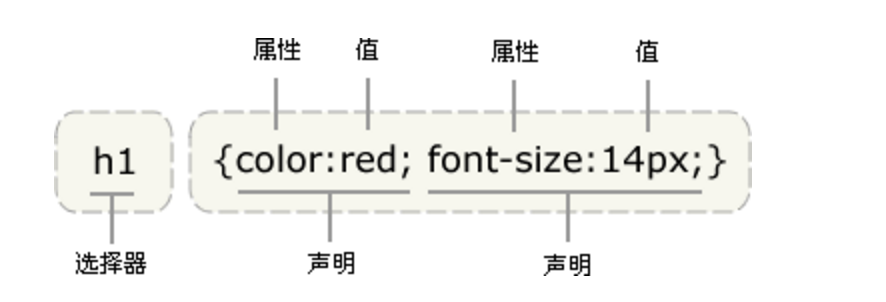
CSS的四种引入方式
1.行内式
行内式是在标记的style属性中设定CSS样式。这种方式没有体现出CSS的优势,不推荐使用。
<p style="background-color: rebeccapurple">hello yuan</p>
2.嵌入式
嵌入式是将CSS样式集中写在网页的<head></head>标签对的<style></style>标签对中。格式如下:
<head> <meta charset="UTF-8"> <title>Title</title> <style> p{ background-color: #2b99ff; } </style> </head>
3 链接式
将一个.css文件引入到HTML文件中
<link href="mystyle.css" rel="stylesheet" type="text/css"/>

外部式css样式,写在单独的一个文件中 外部式css样式(也可称为外联式)就是把css代码写一个单独的外部文件中,这个css样式文件以“.css”为扩展名,在<head>内(不是在<style>标签内)使用<link>标签将css样式文件链接到HTML文件内,如下面代码: <link href="base.css" rel="stylesheet" type="text/css" /> 注意: 1、css样式文件名称以有意义的英文字母命名,如 main.css。 2、rel="stylesheet" type="text/css" 是固定写法不可修改。 3、<link>标签位置一般写在<head>标签之内。

style.css文件: span{ color:red; font-size:20px; } index.html文件: <!DOCTYPE HTML> <html> <head> <meta http-equiv="Content-Type" content="text/html; charset=utf-8"> <title>嵌入式css样式</title> <link href="style.css" rel="stylesheet" type="text/css" /> </head> <body> <p>xx网,<span>超酷的互联网</span>、IT技术免费学习平台,创新的网络一站式学习、实践体验;<span>服务及时贴心</span>,内容专业、<span>有趣易学</span>。专注服务互联网工程师快速成为技术高手!</p> </body> </html>
4.导入式
将一个独立的.css文件引入HTML文件中,导入式使用CSS规则引入外部CSS文件,<style>标记也是写在<head>标记中,使用的语法如下:
<style type="text/css"> @import"mystyle.css"; 此处要注意.css文件的路径 </style>
注意:
导入式会在整个网页装载完后再装载CSS文件,因此这就导致了一个问题,如果网页比较大则会儿出现先显示无样式的页面,闪烁一下之后,再出现网页的样式。这是导入式固有的一个缺陷。使用链接式时与导入式不同的是它会以网页文件主体装载前装载CSS文件,因此显示出来的网页从一开始就是带样式的效果的,它不会象导入式那样先显示无样式的网页,然后再显示有样式的网页,这是链接式的优点。
css选择器
基本选择器
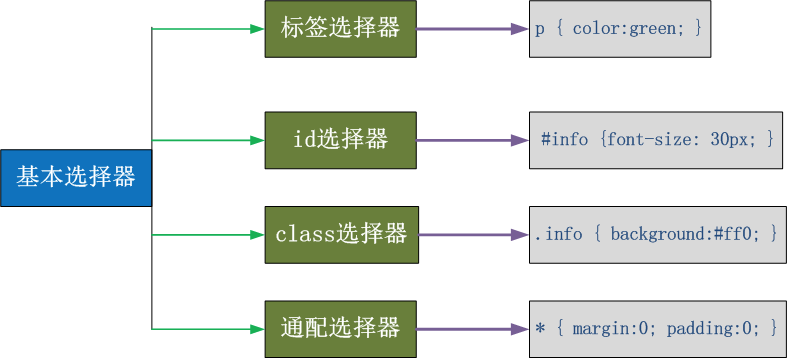
组合选择器
E,F 多元素选择器,同时匹配所有E元素或F元素,E和F之间用逗号分隔 :div,p { color:#f00; }
E F 后代元素选择器,匹配所有属于E元素后代的F元素,E和F之间用空格分隔 :li a { font-weight:bold;}
E > F 子元素选择器,匹配所有E元素的子元素F :div > p { color:#f00; }
E + F 毗邻元素选择器,匹配所有紧随E元素之后的同级元素F :div + p { color:#f00; }
E ~ F 普通兄弟选择器(以破折号分隔) :.div1 ~ p{font-size: 30px; }
注意,关于标签嵌套:
一般,块级元素可以包含内联元素或某些块级元素,但内联元素不能包含块级元素,它只能包含其它内联元素。需要注意的是,p标签不能包含块级标签。
属性选择器
E[att] 匹配所有具有att属性的E元素,不考虑它的值。(注意:E在此处可以省略。
比如“[cheacked]”。以下同。) p[title] { color:#f00; }
E[att=val] 匹配所有att属性等于“val”的E元素 div[class=”error”] { color:#f00; }
E[att~=val] 匹配所有att属性具有多个空格分隔的值、其中一个值等于“val”的E元素
td[class~=”name”] { color:#f00; }
E[attr^=val] 匹配属性值以指定值开头的每个元素
div[class^="test"]{background:#ffff00;}
E[attr$=val] 匹配属性值以指定值结尾的每个元素 div[class$="test"]{background:#ffff00;}
E[attr*=val] 匹配属性值中包含指定值的每个元素 div[class*="test"]{background:#ffff00;}
伪类
anchor伪类:专用于控制链接的显示效果
a:link(没有接触过的链接),用于定义了链接的常规状态。
a:hover(鼠标放在链接上的状态),用于产生视觉效果。
a:visited(访问过的链接),用于阅读文章,能清楚的判断已经访问过的链接。
a:active(在链接上按下鼠标时的状态),用于表现鼠标按下时的链接状态。
伪类选择器 : 伪类指的是标签的不同状态:
a ==> 点过状态 没有点过的状态 鼠标悬浮状态 激活状态
a:link {color: #FF0000} /* 未访问的链接 */
a:visited {color: #00FF00} /* 已访问的链接 */
a:hover {color: #FF00FF} /* 鼠标移动到链接上 */
a:active {color: #0000FF} /* 选定的链接 */ 格式: 标签:伪类名称{ css代码; }
HTML文本示例:

<!DOCTYPE html> <html lang="en"> <head> <meta charset="UTF-8"> <title>Title</title> <style> .top{ background-color: rebeccapurple; width: 100px; height: 100px; } .bottom{ background-color: green; width: 100px; height: 100px; } .outer:hover .bottom{ background-color: yellow; } /*注意:一定是outer:hover 控制outer里某一个标签,否则无效*/ /*.top:hover .bottom{*/ /*background-color: yellow;*/ /*}*/ </style> </head> <body>
browser显示示例:
鼠标未移动到outer区

鼠标移动到outer区
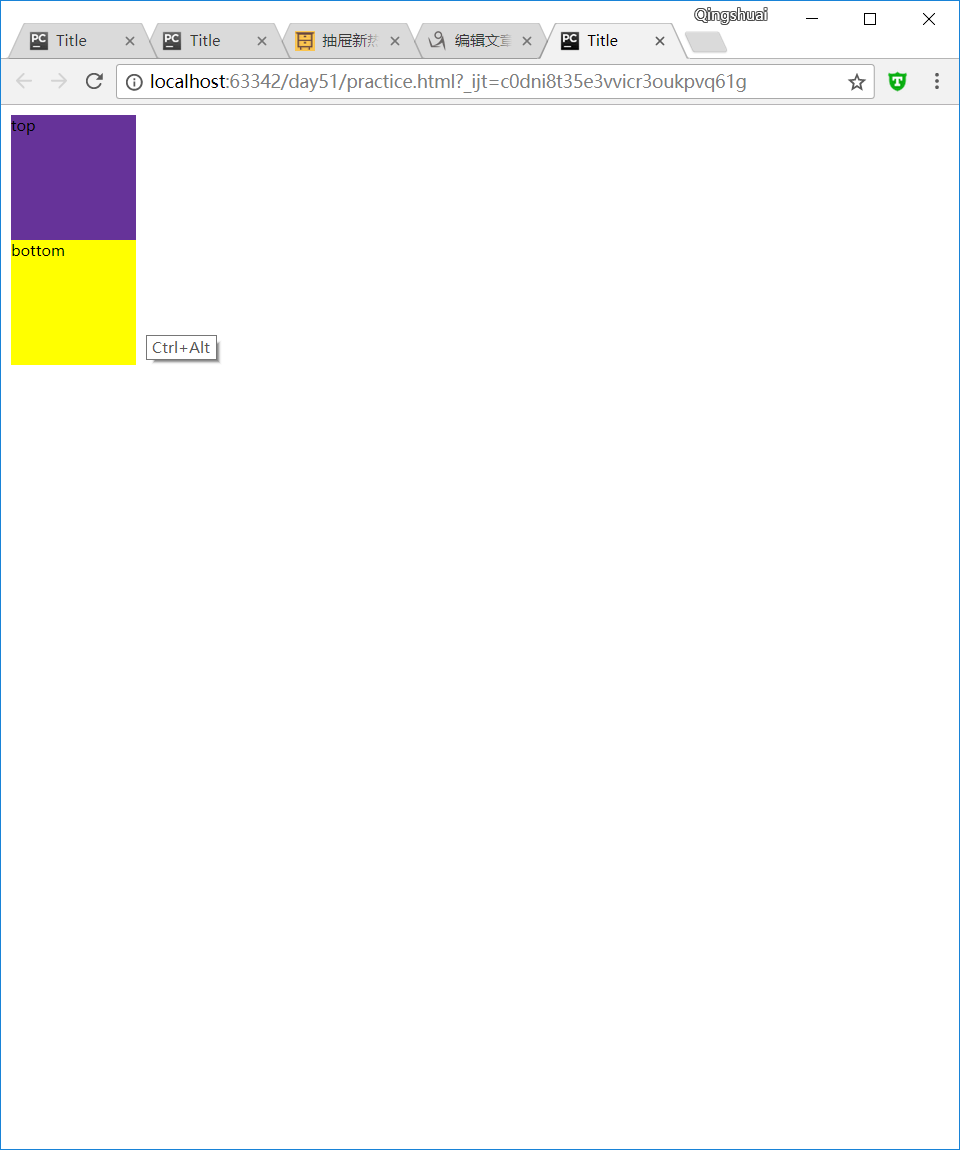
before after伪类
:before p:before 在每个<p>元素之前插入内容 :after p:after 在每个<p>元素之后插入内容 例:p:before{content:"hello";color:red;display: block;}
选择器的优先级
css的继承
继承是CSS的一个主要特征,它是依赖于祖先-后代的关系的。继承是一种机制,它允许样式不仅可以应用于某个特定的元素,还可以应用于它的后代。例如一个BODY定义了的颜色值也会应用到段落的文本中。
body{color:red;} <p>helloyuan</p>
HTML文本示例:

<!DOCTYPE html> <html lang="en"> <head> <meta charset="UTF-8"> <title>Title</title> <style> body{color:red;} </style> </head> <body> <p>hello</p> </body> </html>
browser端展示:
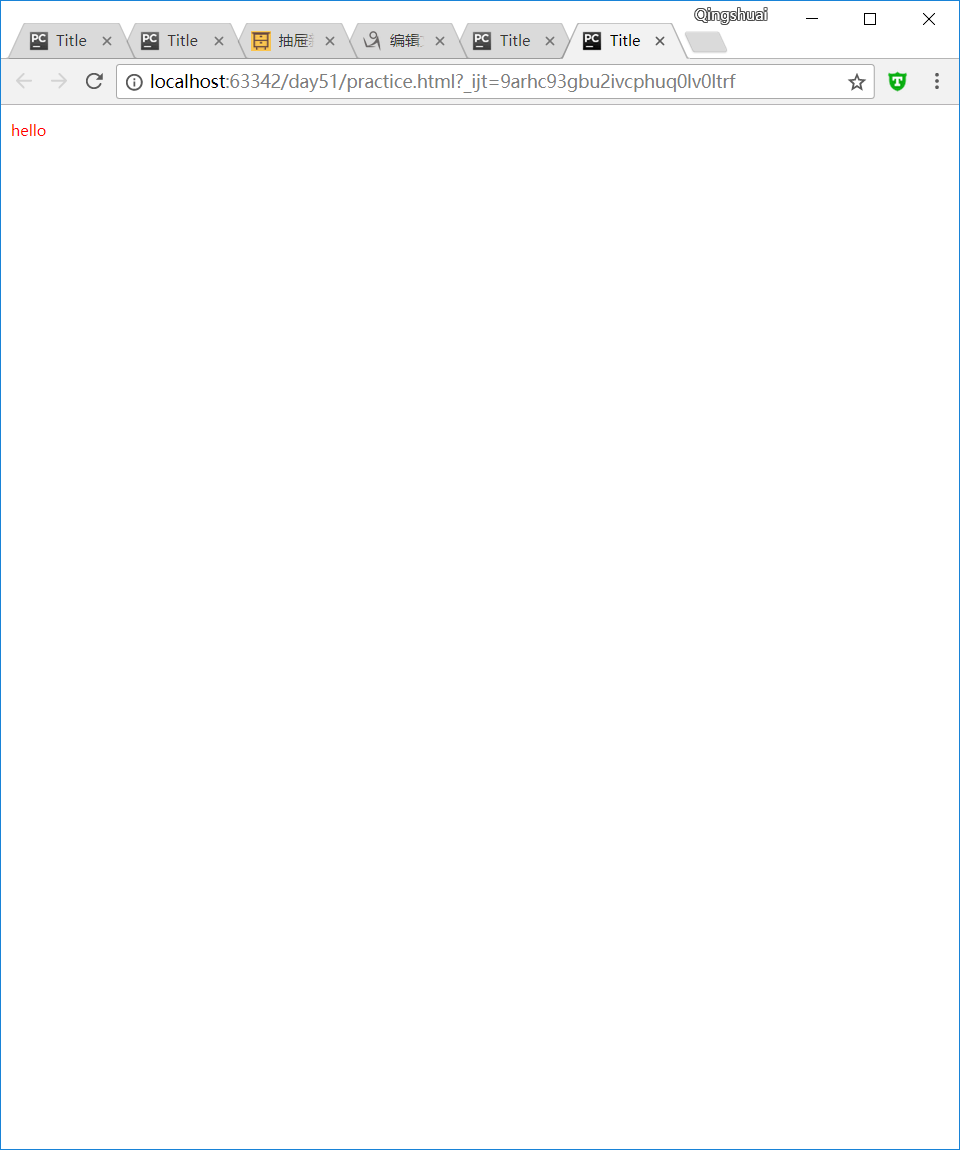
这段文字都继承了由body {color:red;}样式定义的颜色。然而CSS继承性的权重是非常低的,是比普通元素的权重还要低的0。
p{color:green}
HTML文本示例:

<!DOCTYPE html> <html lang="en"> <head> <meta charset="UTF-8"> <title>Title</title> <style> body{color:red;} p{color:green} </style> </head> <body> <p>hello</p> </body> </html>
browser端展示:

发现只需要给加个颜色值就能覆盖掉它继承的样式颜色。由此可见:任何显示申明的规则都可以覆盖其继承样式。
此外,继承是CSS重要的一部分,我们甚至不用去考虑它为什么能够这样,但CSS继承也是有限制的。有一些属性不能被继承,如:border, margin, padding, background等。
HTML文本示例:

<!DOCTYPE html> <html lang="en"> <head> <meta charset="UTF-8"> <title>Title</title> <style> div{border:1px solid #222} </style> </head> <body> <div>hello <p>yuan</p> </div> </body> </html>
browser端展示:
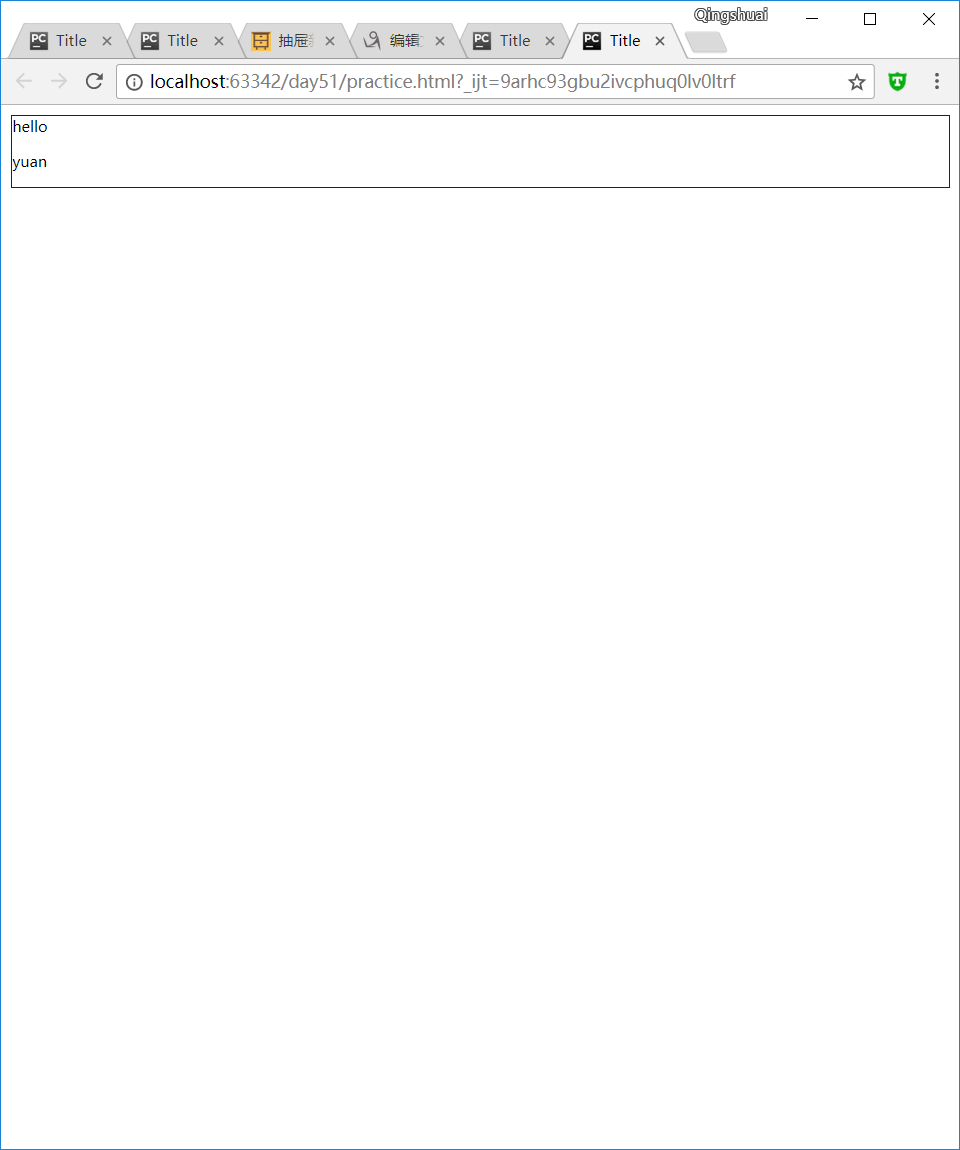
css的优先级
所谓CSS优先级,即是指CSS样式在浏览器中被解析的先后顺序。
样式表中的特殊性描述了不同规则的相对权重,它的基本规则是:
1 内联样式表的权值最高 style=""------------1000;
2 统计选择符中的ID属性个数。 #id --------------100
3 统计选择符中的CLASS属性个数。 .class -------------10
4 统计选择符中的HTML标签名个数。 p ---------------1
按这些规则将数字符串逐位相加,就得到最终的权重,然后在比较取舍时按照从左到右的顺序逐位比较。
1、文内的样式优先级为1,0,0,0,所以始终高于外部定义。
2、有!important声明的规则高于一切。
3、如果!important声明冲突,则比较优先权。
4、如果优先权一样,则按照在源码中出现的顺序决定,后来者居上。
5、由继承而得到的样式没有specificity的计算,它低于一切其它规则(比如全局选择符*定义的规则)。
css属性操作
css text
文本颜色:color
颜色属性被用来设置文字的颜色。
颜色是通过CSS最经常的指定:
- 十六进制值 - 如: #FF0000
- 一个RGB值 - 如: RGB(255,0,0)
- 颜色的名称 - 如: red
p { color: rebeccapurple; }
HTML文本示例:

<!DOCTYPE html> <html lang="en"> <head> <meta charset="UTF-8"> <title>Title</title> <style> div{color: chartreuse;} p{color: rebeccapurple;} </style> </head> <body> <div>hello <p>yuan</p> </div> </body> </html>
Browser端展示:
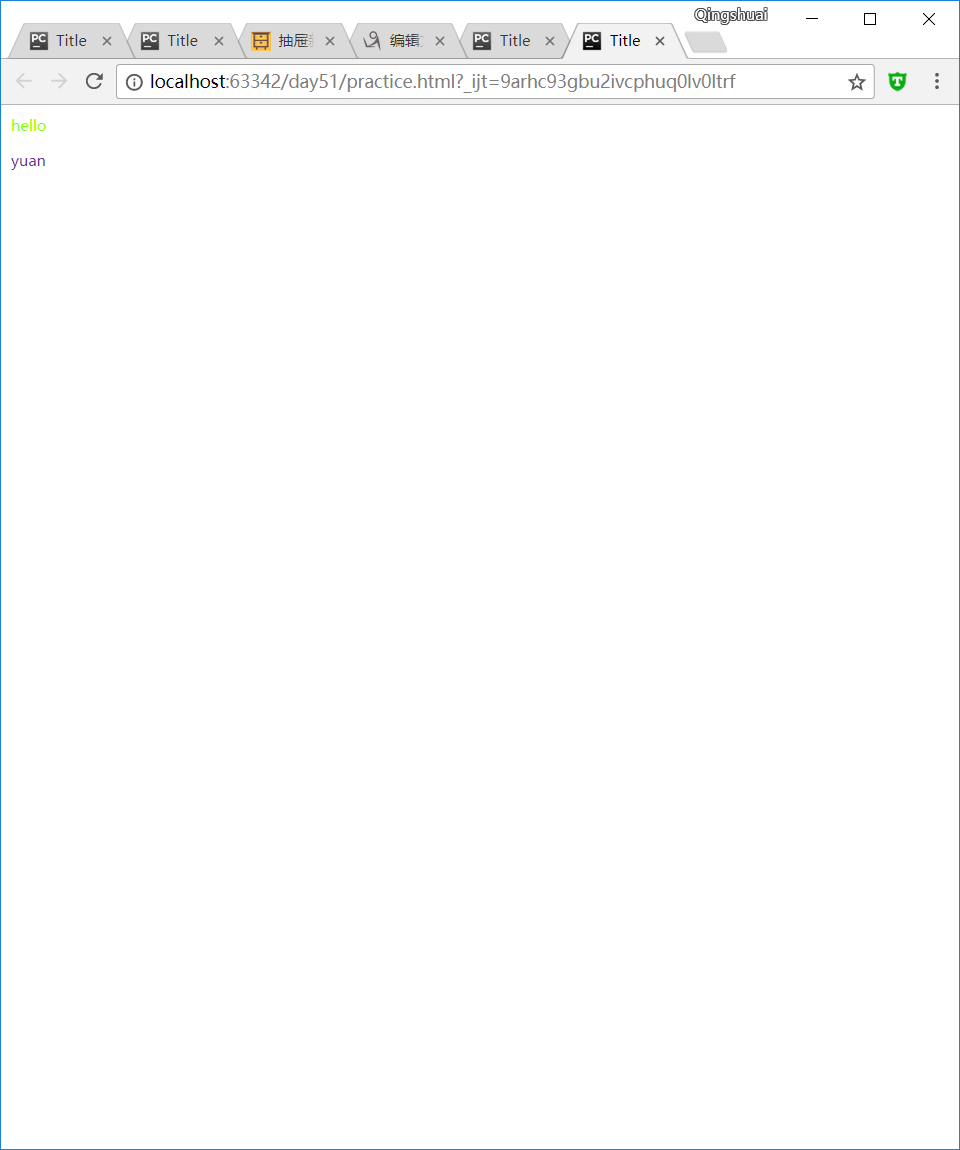
水平对齐方式
text-align 属性规定元素中的文本的水平对齐方式。
- left 把文本排列到左边。默认值:由浏览器决定。
- right 把文本排列到右边。
- center 把文本排列到中间。
- justify 实现两端对齐文本效果。
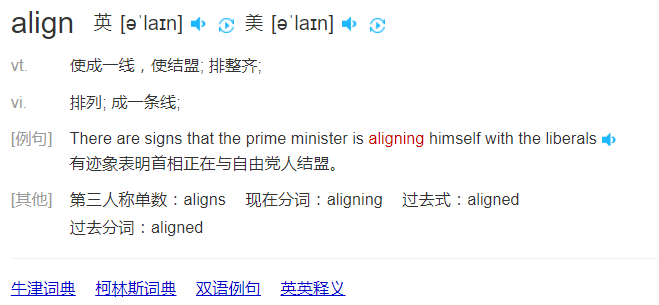
HTML文本示例:

<!DOCTYPE html> <html lang="en"> <head> <meta charset="utf-8"> <title>css</title> <style> h1 {text-align:center;} p.publish_time {text-align:right;} p.content {text-align:justify;} </style> </head> <body> <h1>CSS text-align 水平居中</h1> <p class="publish_time">2017 年 5 月 17 号</p> <p class="content"> 有个落拓不得志的中年人每隔三两天就到教堂祈祷,而且他的祷告词几乎每次都相同。第一次他到教堂时, 跪在圣坛前,虔诚地低语:“上帝啊,请念在我多年来敬畏您的份上。让我中一次彩票吧!阿门。” 几天后,他又垂头丧气回到教堂,同样跪着祈祷:“上帝啊,为何不让我中彩票?我愿意更谦卑地来 服侍你,求您让我中一次彩票吧!阿门。”又过了几天,他再次出现在教堂,同样重复他的祈祷。如此周而 复始,不间断地祈求着。到了最后一次,他跪着:“我的上帝,为何您不垂听我的祈求?让我中一次彩票吧! 只要一次,让我解决所有困难,我愿终身奉献,专心侍奉您……”就在这时,圣坛上发出一阵宏伟庄严的声 音:“我一直垂听你的祷告。可是最起码?你也该先去买一张彩票吧!”</p> <p><b>注意:</b> 重置浏览器窗口大小查看 "justify" 是如何工作的。</p> </body> </html>
Browser端展示:
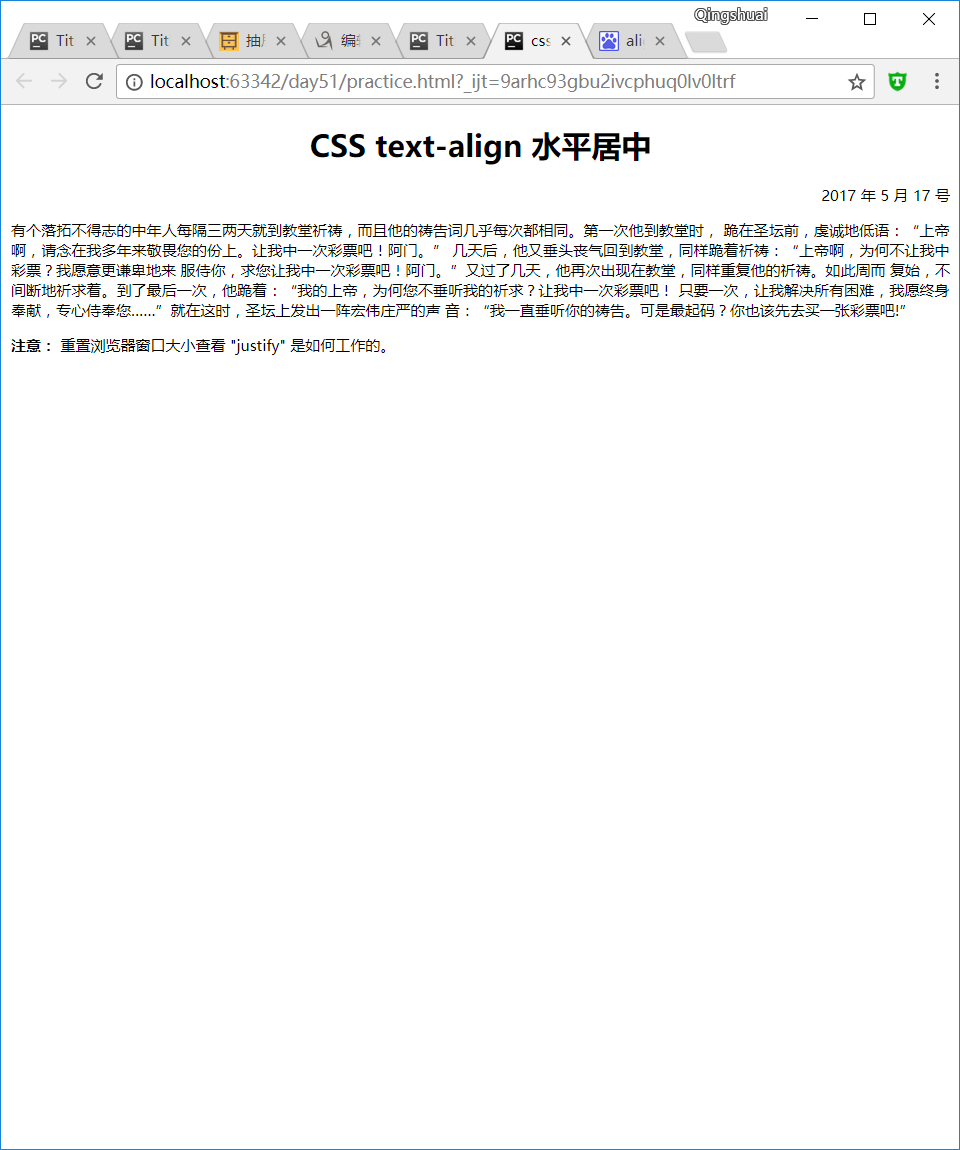
文本其它属性
font-size: 10px;
line-height: 200px; 文本行高 通俗的讲,文字高度加上文字上下的空白区域的高度 50%:基于字体大小的百分比
vertical-align:-4px 设置元素内容的垂直对齐方式 ,只对行内元素有效,对块级元素无效
text-decoration:none text-decoration 属性用来设置或删除文本的装饰。主要是用来删除链接的下划线
font-family: 'Lucida Bright'
font-weight: lighter/bold/border/
font-style: oblique
text-indent: 150px; 首行缩进150px
letter-spacing: 10px; 字母间距
word-spacing: 20px; 单词间距
text-transform: capitalize/uppercase/lowercase ; 文本转换,用于所有字句变成大写或小写字母,或每个单词的首字母大写
背景属性
属性介绍
- background-color
- background-image
- background-repeat
- background-position
background-color: cornflowerblue
background-image: url('1.jpg');
background-repeat: no-repeat;(repeat:平铺满)
background-position: right top(20px 20px);
HTML文件示例(边框):

<!DOCTYPE html> <html lang="en"> <head> <meta charset="UTF-8"> <title>Title</title> <style> .c1{ width: 100%; height: 600px; border: 1px solid red; /*background-color: #2459a2;*/ /*background-image: url("meinv.png");*/ /*background-repeat: no-repeat;*/ /*background-position: center center;*/ /*background: no-repeat center center url("meinv.png") ;*/ } </style> </head> <body> <div class="c1"></div> </body> </html>
Browser端展示:

HTML文件示例(填充颜色):

<!DOCTYPE html> <html lang="en"> <head> <meta charset="UTF-8"> <title>Title</title> <style> .c1{ width: 100%; height: 600px; border: 1px solid red; background-color: #2459a2; /*background-image: url("meinv.png");*/ /*background-repeat: no-repeat;*/ /*background-position: center center;*/ /*background: no-repeat center center url("meinv.png") ;*/ } </style> </head> <body> <div class="c1"></div> </body> </html>
Browser端展示:

HTML文件示例(图片反复出现铺满背景):

<!DOCTYPE html> <html lang="en"> <head> <meta charset="UTF-8"> <title>Title</title> <style> .c1{ width: 100%; height: 800px; border: 1px solid red; background-color: #2459a2; background-image: url("meinv.png"); /*background-repeat: no-repeat;*/ /*background-position: center center;*/ /*background: no-repeat center center url("meinv.png") ;*/ } </style> </head> <body> <div class="c1"></div> </body> </html>
Browser端展示:

HTML文件示例(图片出现一次,不重复):

<!DOCTYPE html> <html lang="en"> <head> <meta charset="UTF-8"> <title>Title</title> <style> .c1{ width: 100%; height: 800px; border: 1px solid red; background-color: #2459a2; background-image: url("meinv.png"); background-repeat: no-repeat; /*background-position: center center;*/ /*background: no-repeat center center url("meinv.png") ;*/ } </style> </head> <body> <div class="c1"></div> </body> </html>
Browser端展示:

HTML文件示例(图片不重复,居中):

<!DOCTYPE html> <html lang="en"> <head> <meta charset="UTF-8"> <title>Title</title> <style> .c1{ width: 100%; height: 800px; border: 1px solid red; background-color: #2459a2; background-image: url("meinv.png"); background-repeat: no-repeat; background-position: center center; /*background: no-repeat center center url("meinv.png") ;*/ } </style> </head> <body> <div class="c1"></div> </body> </html>
Browser端展示:
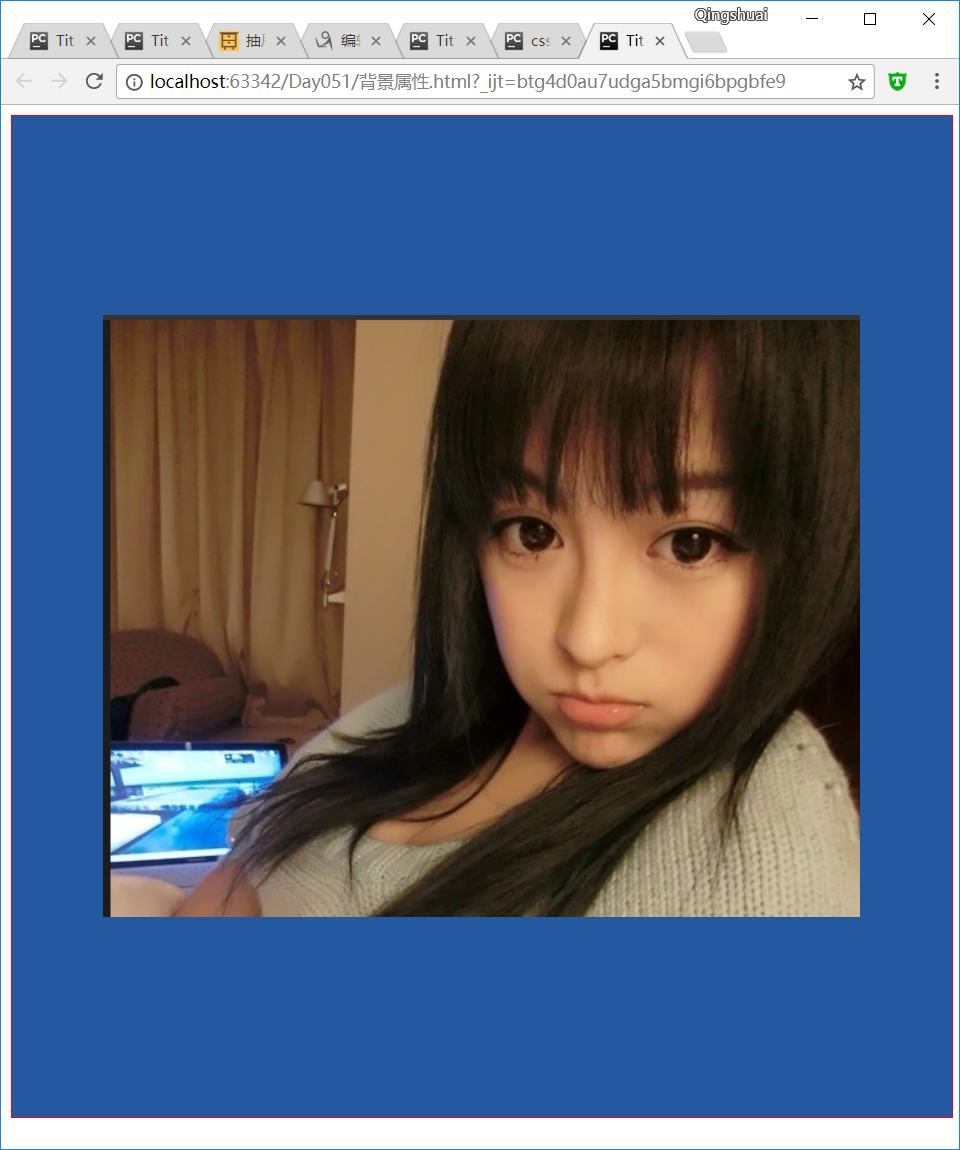
简写
background:#ffffff url('1.png') no-repeat right top;
HTML文件示例(简写):

<!DOCTYPE html> <html lang="en"> <head> <meta charset="UTF-8"> <title>Title</title> <style> .c1{ width: 100%; height: 800px; border: 1px solid red; background-color: #2459a2; /*background-image: url("meinv.png");*/ /*background-repeat: no-repeat;*/ /*background-position: center center;*/ background: no-repeat center center url("meinv.png") ; } </style> </head> <body> <div class="c1"></div> </body> </html>
Browser端展示:
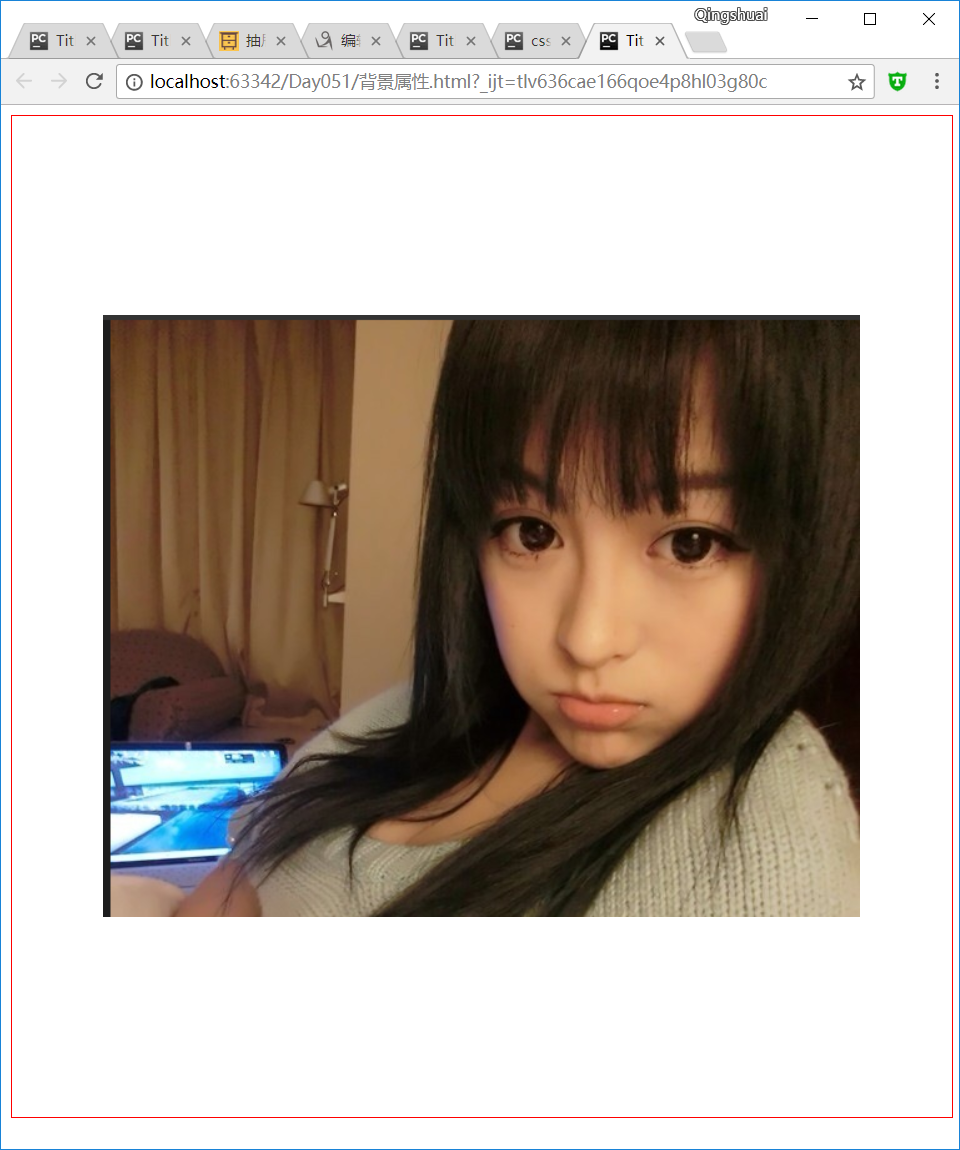
边框属性
属性介绍
- border-width
- border-style (required)
- border-color
border-style: solid;
border-color: chartreuse;
border-width: 20px;
简写
border: 30px rebeccapurple solid;
边框-单独设置各边
border-top-style:dotted;
border-right-style:solid;
border-bottom-style:dotted;
border-left-style:none;
HTML文件示例:

<!DOCTYPE html> <html lang="en"> <head> <meta charset="UTF-8"> <title>Title</title> <style> .c1{ width: 200px; height: 200px; border-color: #2b47ff; border-style: dotted; border-width: 13px; /*border: 1px red dashed;*/ /*border-right: 1px red dashed;*/ /*border-radius: 100%;*/ } </style> </head> <body> <div class="c1"></div> </body> </html>
Browser端展示:

HTML文件示例(简写版):

<!DOCTYPE html> <html lang="en"> <head> <meta charset="UTF-8"> <title>Title</title> <style> .c1{ width: 200px; height: 200px; border: 1px red dashed; } </style> </head> <body> <div class="c1"></div> </body> </html>
Browser端展示:
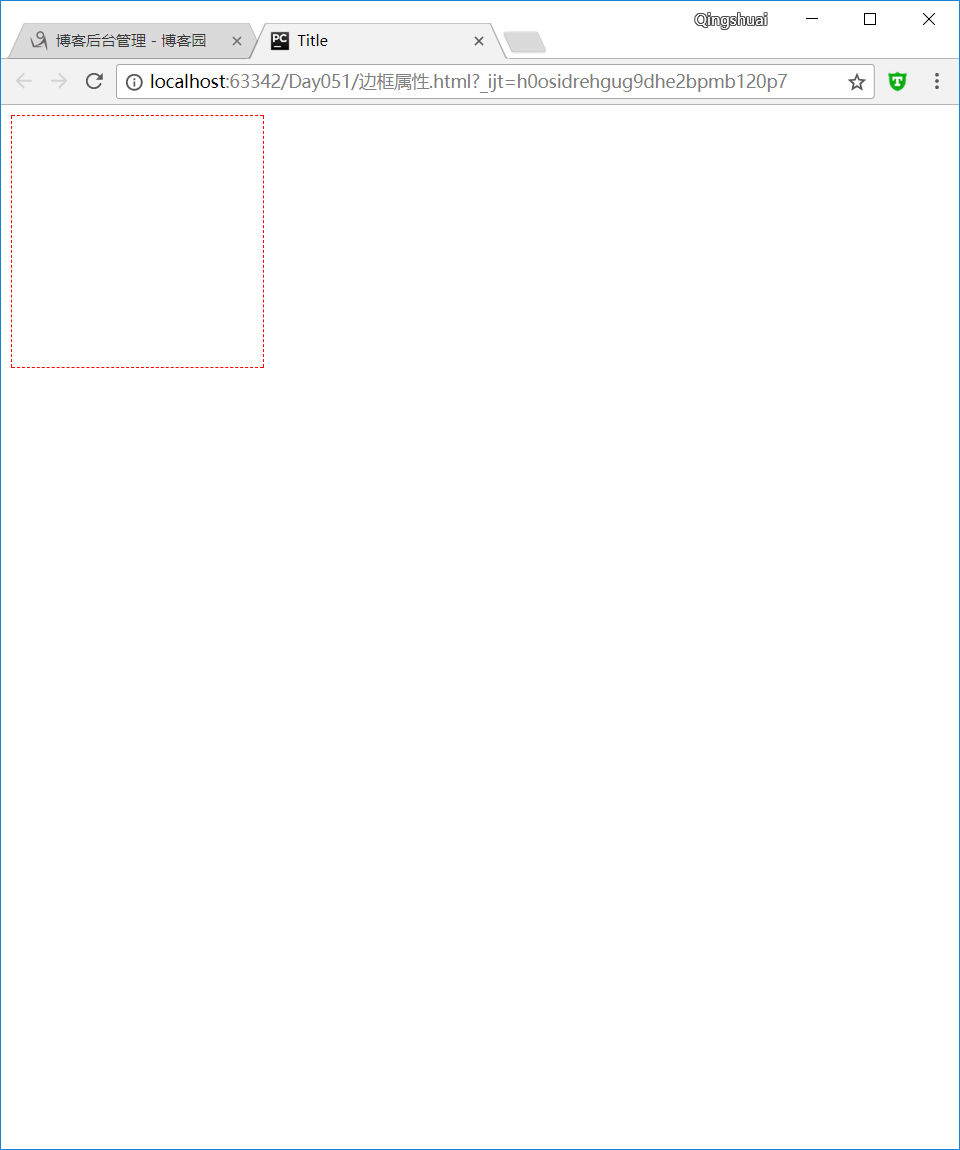
HTML文件示例(单独一边设置):

<!DOCTYPE html> <html lang="en"> <head> <meta charset="UTF-8"> <title>Title</title> <style> .c1{ width: 200px; height: 200px; border-right: 1px red dashed; } </style> </head> <body> <div class="c1"></div> </body> </html>
Browser端展示:

HTML文件示例(圆边框):

<!DOCTYPE html> <html lang="en"> <head> <meta charset="UTF-8"> <title>Title</title> <style> .c1{ width: 200px; height: 200px; border-color: #2b47ff; border-style: dotted; border-width: 9px; border-radius: 100%; } </style> </head> <body> <div class="c1"></div> </body> </html>
Browser端展示:
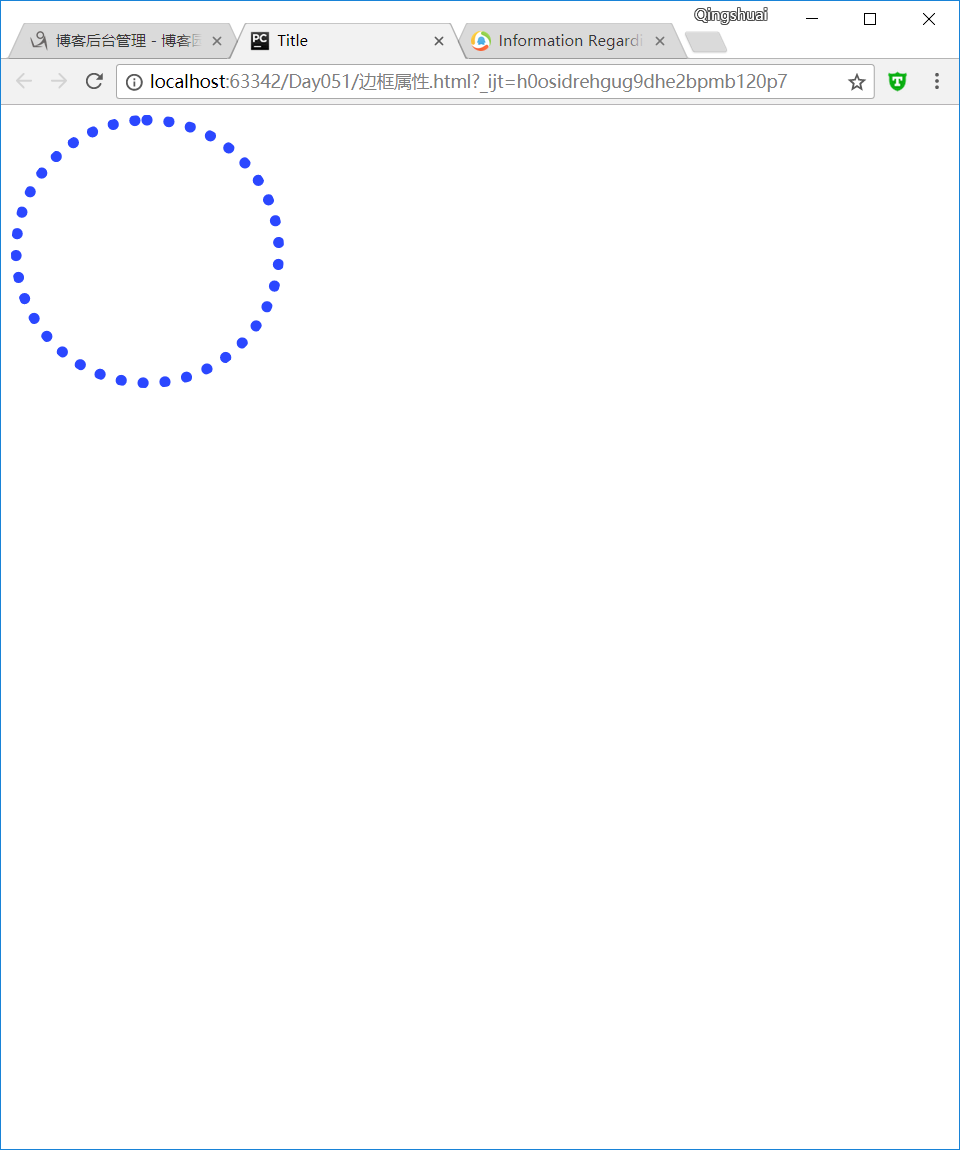
HTML文件示例(半圆边框):

<!DOCTYPE html> <html lang="en"> <head> <meta charset="UTF-8"> <title>Title</title> <style> .c1{ width: 200px; height: 200px; border-right: 4px red dashed; border-radius: 100%; } </style> </head> <body> <div class="c1"></div> </body> </html>
Browser端展示:
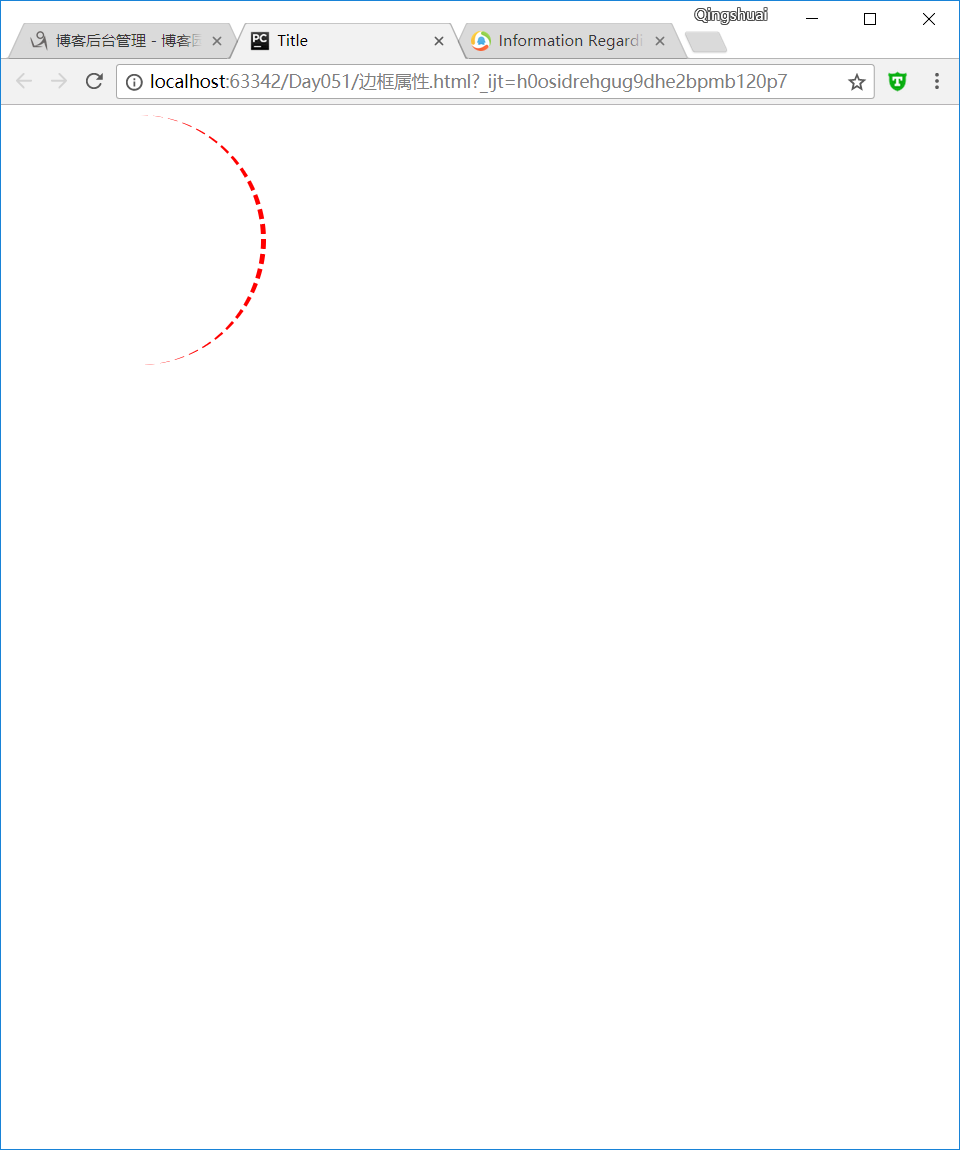
HTML文件示例(文字):

<!DOCTYPE html> <html lang="en"> <head> <meta charset="UTF-8"> <title>Title</title> <style> span{ padding: 10px; background-color: #369; border-radius: 20%; } </style> </head> <body> <span>2</span> </body> </html>
Browser端展示:
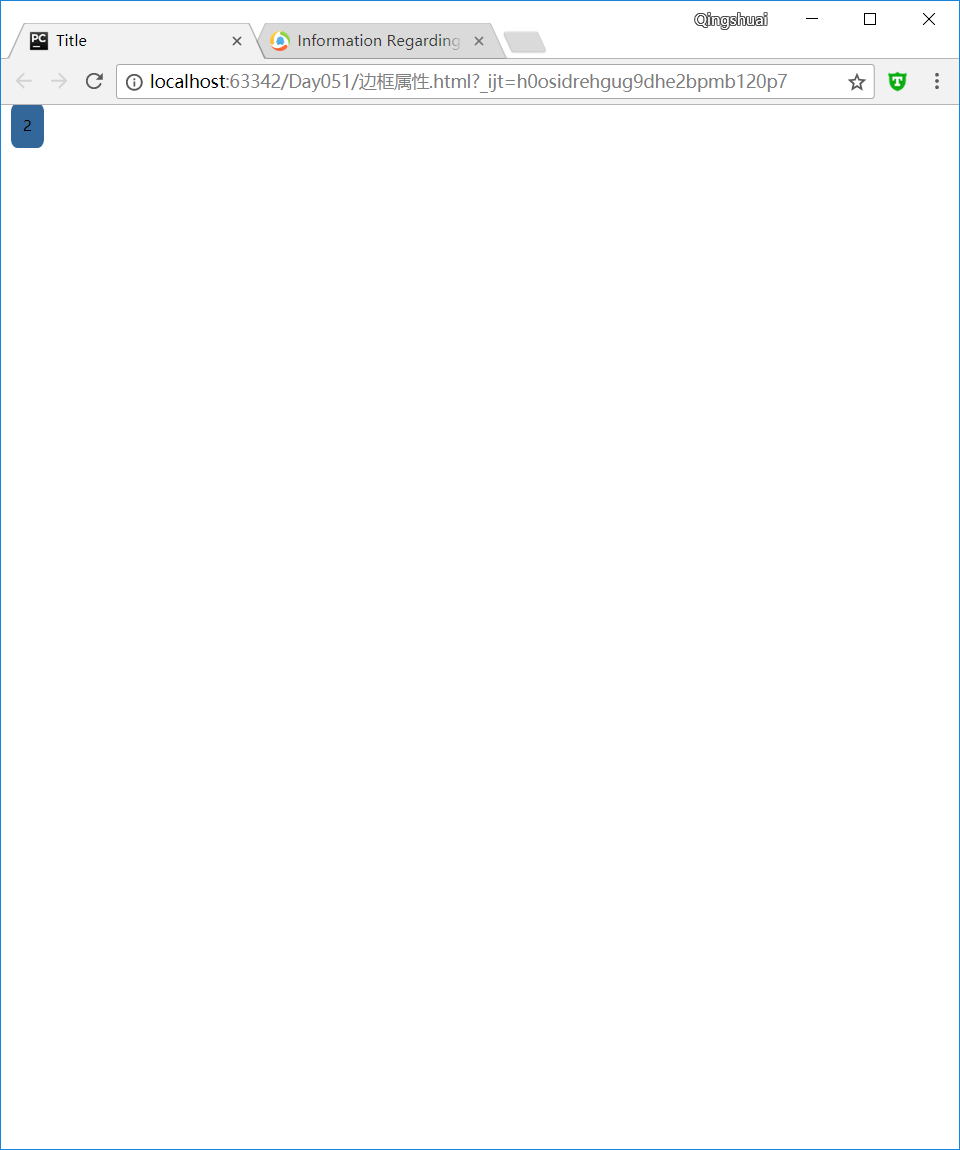
列表属性
list-style-type 设置列表项标志的类型。
list-style-image 将图象设置为列表项标志。
list-style-position 设置列表中列表项标志的位置。
list-style 简写属性。用于把所有用于列表的属性设置于一个声明中
ist-style-type属性指定列表项标记的类型:
ul { list-style-type: square; }
使用图像来替换列表项的标记:
ul { list-style-image: url(''); }
HTML文件示例(无序列表):

<!DOCTYPE html> <html lang="en"> <head> <meta charset="UTF-8"> <title>Title</title> <style> .c1{ list-style: none; } </style> </head> <body> <ul class="c1"> <li>111</li> <li>111</li> <li>111</li> </ul> </body> </html>
Browser端展示:

HTML文件示例(去无序列表前的空白):

<!DOCTYPE html> <html lang="en"> <head> <meta charset="UTF-8"> <title>Title</title> <style> .c1{ list-style: none; padding: 0; } </style> </head> <body> <ul class="c1"> <li>111</li> <li>111</li> <li>111</li> </ul> </body> </html>
Browser端展示:
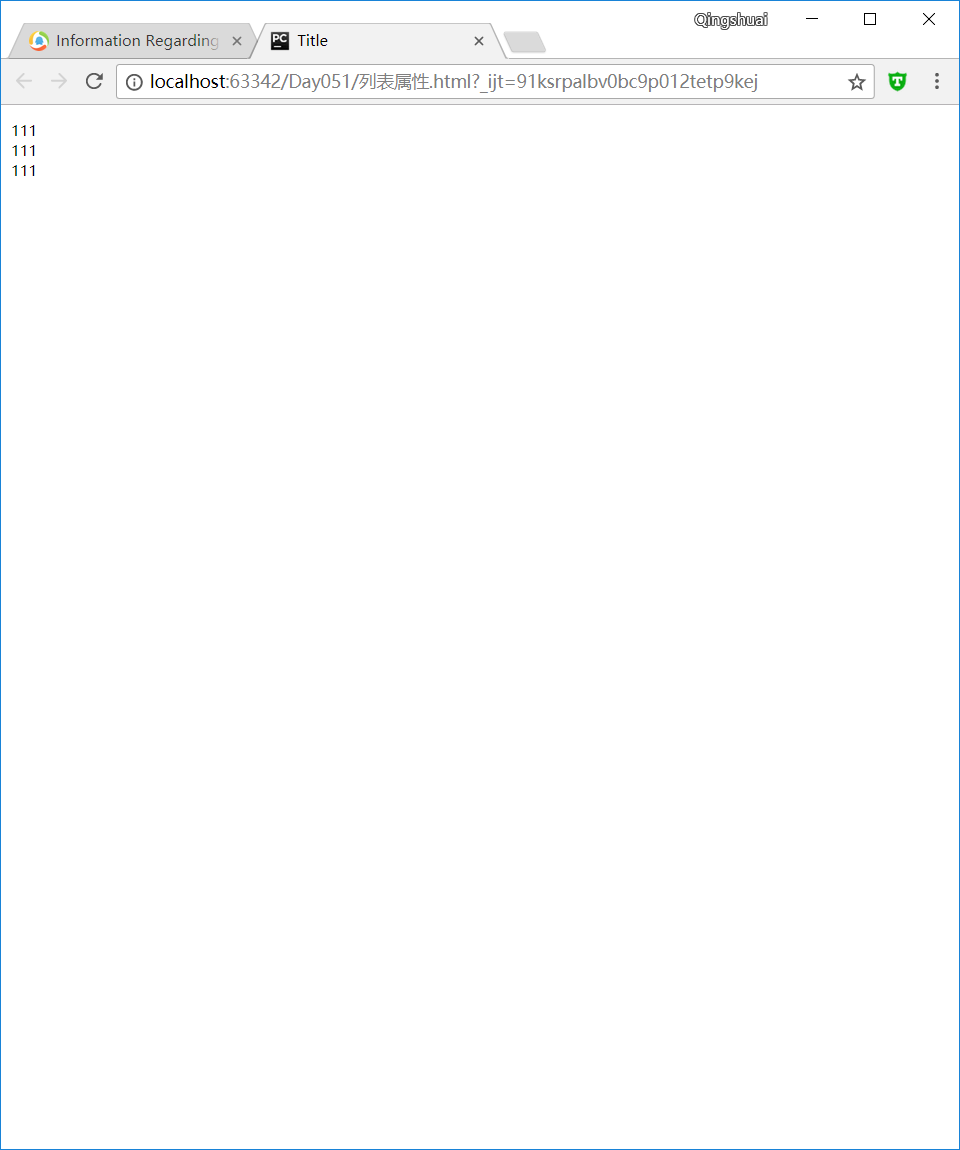
HTML文件示例(小方块提示):

<!DOCTYPE html> <html lang="en"> <head> <meta charset="UTF-8"> <title>Title</title> <style> ul { list-style-type: square; } </style> </head> <body> <ul class="c1"> <li>111</li> <li>111</li> <li>111</li> </ul> </body> </html>
Browser端展示:

HTML文件示例(小方块提示):

<!DOCTYPE html> <html lang="en"> <head> <meta charset="UTF-8"> <title>Title</title> <style> ul { list-style-image: url("drawlogo.png"); } </style> </head> <body> <ul class="c1"> <li>111</li> <li>111</li> <li>111</li> </ul> </body> </html>
Browser端展示:
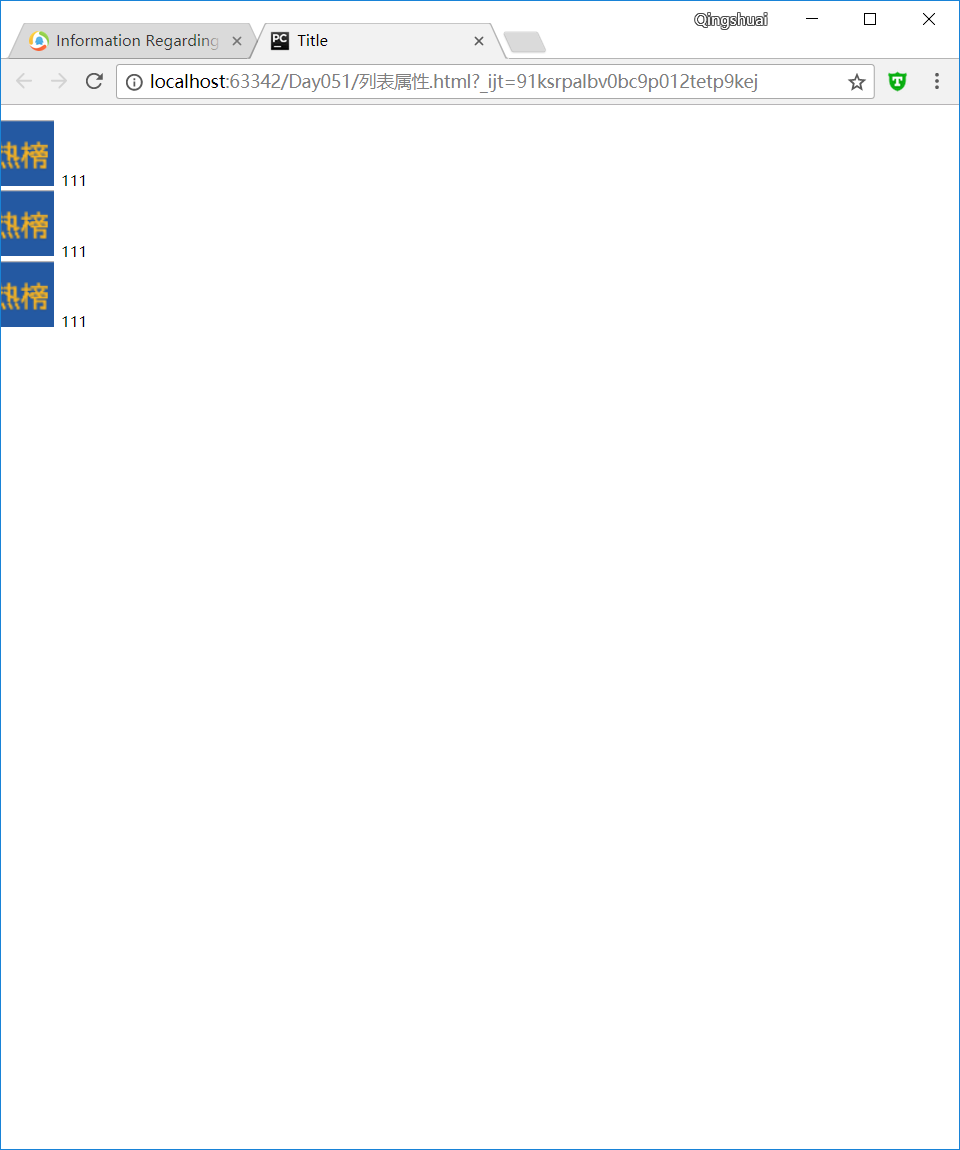
display属性
- none
blockinline- inline-block
none(隐藏某标签)
p{display:none;}
注意:一个内联元素设置为display:block是不允许它有内部的嵌套块元素
inline(块级标签设置为内联标签)
li {display:inline;}
inline-block
#outer{
border: 3px dashed;
word-spacing: -5px;
}
外边距(margine)和内边距(padding)
盒子模型


- margin: 用于控制元素与元素之间的距离;margin的最基本用途就是控制元素周围空间的间隔,从视觉角度上达到相互隔开的目的。
- padding: 用于控制内容与边框之间的距离。
- Border(边框): 围绕在内边距和内容外的边框。
- Content(内容): 盒子的内容,显示文本和图像。
margine(外边距)
单边外边距属性:
margin-top:100px;
margin-bottom:100px;
margin-right:50px;
margin-left:50px;
简写属性
margin:10px 20px 20px 10px;
上边距为10px
右边距为20px
下边距为20px
左边距为10px
margin:10px 20px 10px;
上边距为10px
左右边距为20px
下边距为10px
margin:10px 20px;
上下边距为10px
左右边距为20px
margin:25px;
所有的4个边距都是25px
居中应用
margin: 0 auto;
HTML文本示例

<!DOCTYPE html> <html lang="en"> <head> <meta charset="UTF-8"> <title>Title</title> <style> .c1{ width: 200px; height: 200px; border-color: #2b47ff; border-style: dotted; border-width: 9px; } .c2{ width: 200px; height: 200px; border: 4px red dashed; } .c3{ width: 200px; height: 200px; border: 4px red dashed; border-radius: 100%; } span{ padding: 10px; background-color: #369; border-radius: 20%; } </style> </head> <body> <div class="c1"></div> <div class="c2"></div> <div class="c3"></div> <span>2</span> </body> </html>
Browser端展示
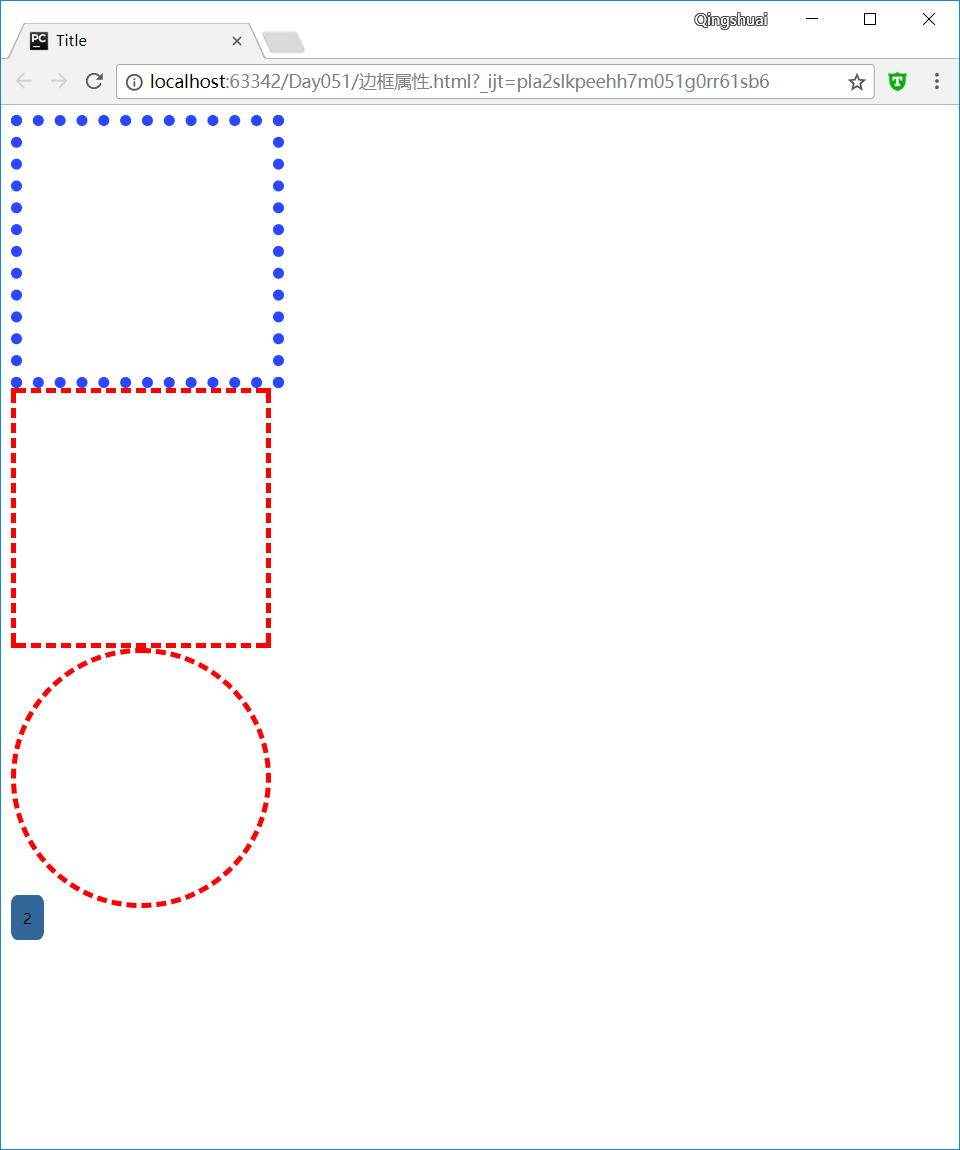
padding(内边距)
单独使用填充属性可以改变上下左右的填充。缩写填充属性也可以使用,一旦改变一切都改变。设置同margine。
HTML文件页码的实例:

<!DOCTYPE html> <html lang="en"> <head> <meta charset="UTF-8"> <title>Title</title> <style> .outer{ margin: 0 auto; width: 80%; } .content{ background-color: darkgrey; height: 500px; } a{ text-decoration: none; } .page-area{ text-align: center; padding-top: 30px; padding-bottom: 30px; background-color: #f0ad4e; } .page-area ul li{ display: inline-block; } .page-area ul li a ,.page-area ul li span{ display: inline-block; color: #369; height: 25px; width: 25px; text-align: center; line-height: 25px; padding: 8px; margin-left: 8px; border: 1px solid #e1e1e1; border-radius: 15%; } .page-area ul li .page-next{ width: 70px; border-radius:0 } .page-area ul li span.current_page{ border: none; color: black; font-weight:900; } .page-area ul li a:hover{ color: #fff; background-color: #2459a2; } </style> </head> <body> <div class="outer"> <div class="content"></div> <div class="page-area"> <ul> <li><span class="current_page">1</span></li> <li><a href="#" class="page-a">2</a></li> <li><a href="#" class="page-a">3</a></li> <li><a href="#" class="page-a">4</a></li> <li><a href="#" class="page-a">5</a></li> <li><a href="#" class="page-a">6</a></li> <li><a href="#" class="page-a">7</a></li> <li><a href="#" class="page-a">8</a></li> <li><a href="#" class="page-a">9</a></li> <li><a href="#" class="page-a">10</a></li> <li><a href="#" class="page-a page-next">下一页</a></li> </ul> </div> </div> </body> </html>
Browser端展示

鼠标移动到悬浮区:
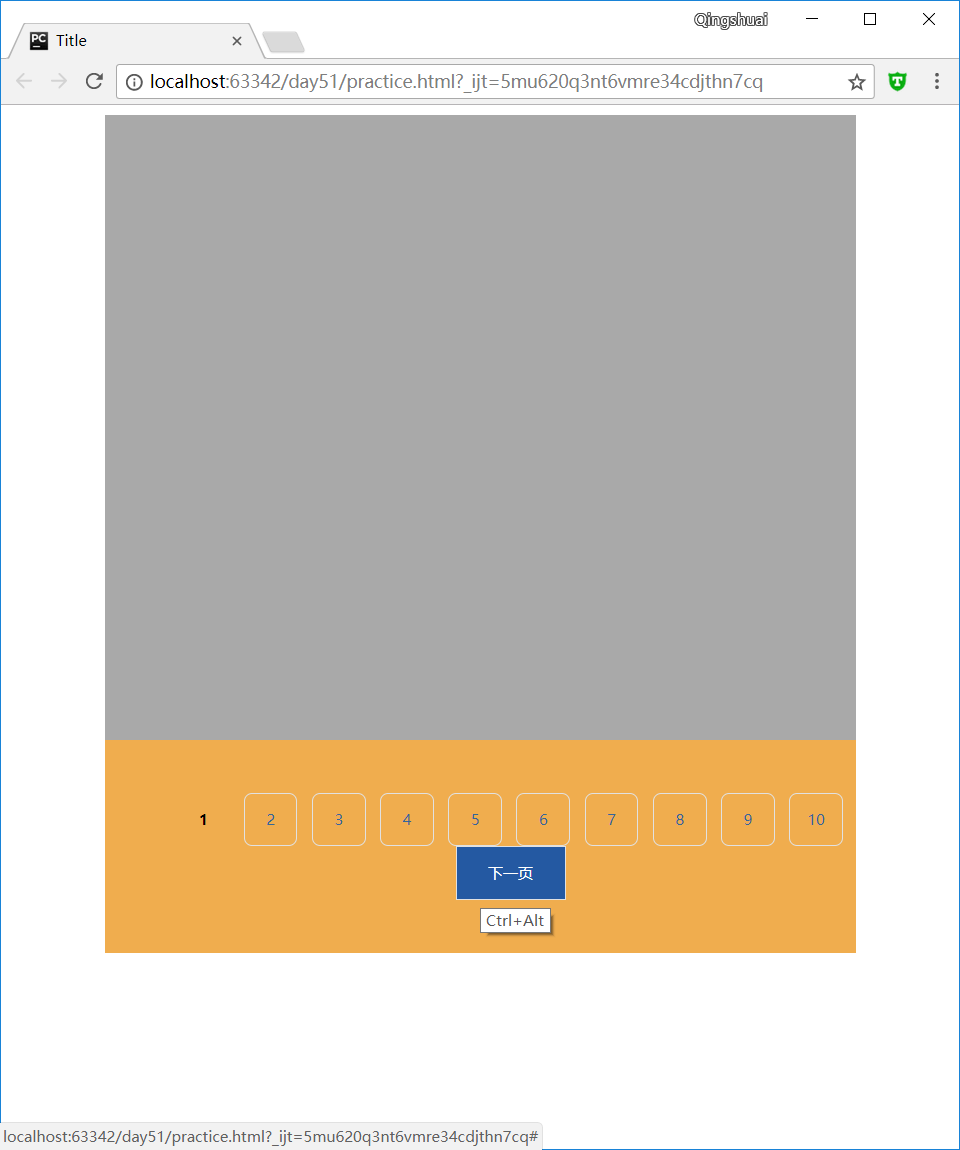
思考1:body的外边距
边框在默认情况下会定位于浏览器窗口的左上角,但是并没有紧贴着浏览器的窗口的边框,这是因为body本身也是一个盒子(外层还有html),在默认情况下, body距离html会有若干像素的margin,具体数值因各个浏览器不尽相同,所以body中的盒子不会紧贴浏览器窗口的边框了,为了验证这一点,加上:
body{
border: 1px solid;
background-color: cadetblue;
}
解决方法:
body{
margin: 0;
}
HTLM文本示例:

<!DOCTYPE html> <html lang="en"> <head> <meta charset="UTF-8"> <title>Title</title> <style> body{ border: 1px solid; background-color: chartreuse; color:red; #本来文字显示这色 } p{color:green} #有这个,就显示这个 </style> </head> <body> <p>hello</p> <p>hello</p> </body> </html>
Browser端展示:
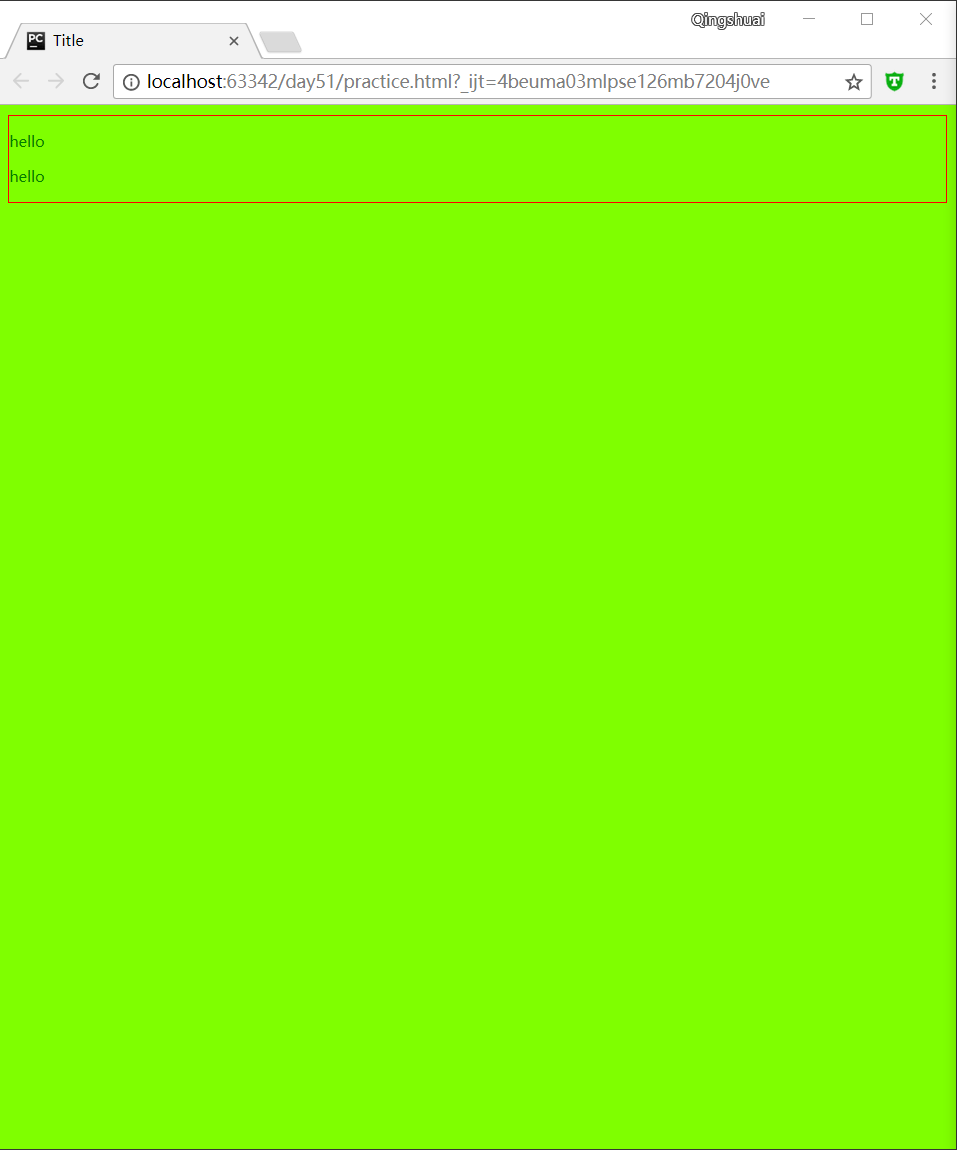
思考2:margin collapse(边界塌陷或者说边界重叠)
1、兄弟div:
上面div的margin-bottom和下面div的margin-top会塌陷,也就是会取上下两者margin里最大值作为显示值。
2、父子div:
if 父级div中没有border,padding,inlinecontent,子级div的margin会一直向上找,直到找到某个标签包括border,padding,inline content中的其中一个,然后按此div 进行margin。
HTML文本演示(边界塌陷):

<!DOCTYPE html> <html lang="en" style="padding:0px"> <head> <meta charset="UTF-8"> <title>Title</title> <style> body{ margin: 0px; } .div1{ background-color: rebeccapurple; width: 300px; height: 300px; } .div2{ background-color: green; width: 100px; height: 100px; margin-bottom: 40px; margin-top: 20px; } .div3{ background-color:teal; width: 100px; height: 100px; margin-top: 20px; } </style> </head> <body> <div style="background-color: bisque;width: 300px;height: 300px">yeah</div> <div class="div1"> <!--yeah--> <div class="div2">oh</div> <div class="div3">a</div> </div> </body> </html>
Browser端展示:
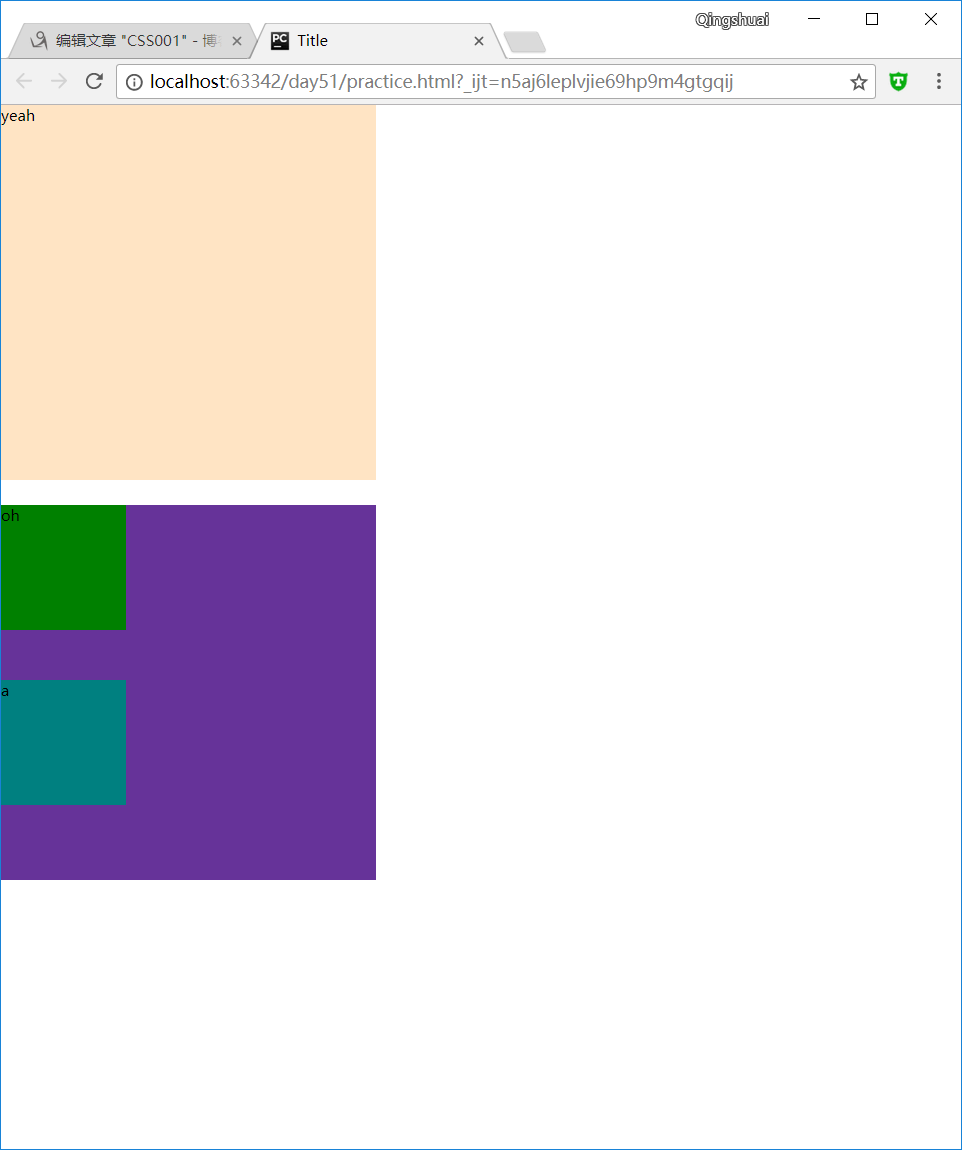
解决方法:
overflow: hidden;
HTML文本演示:

<!DOCTYPE html> <html lang="en" style="padding:0px"> <head> <meta charset="UTF-8"> <title>Title</title> <style> body{ margin: 0px; } .div1{ background-color: rebeccapurple; width: 300px; height: 300px; overflow: hidden; } .div2{ background-color: green; width: 100px; height: 100px; margin-bottom: 40px; margin-top: 20px; } .div3{ background-color:teal; width: 100px; height: 100px; margin-top: 20px; } </style> </head> <body> <div style="background-color: bisque;width: 300px;height: 300px">yeah</div> <div class="div1"> <!--yeah--> <div class="div2">oh</div> <div class="div3">a</div> </div> </body> </html>
Browser端展示:
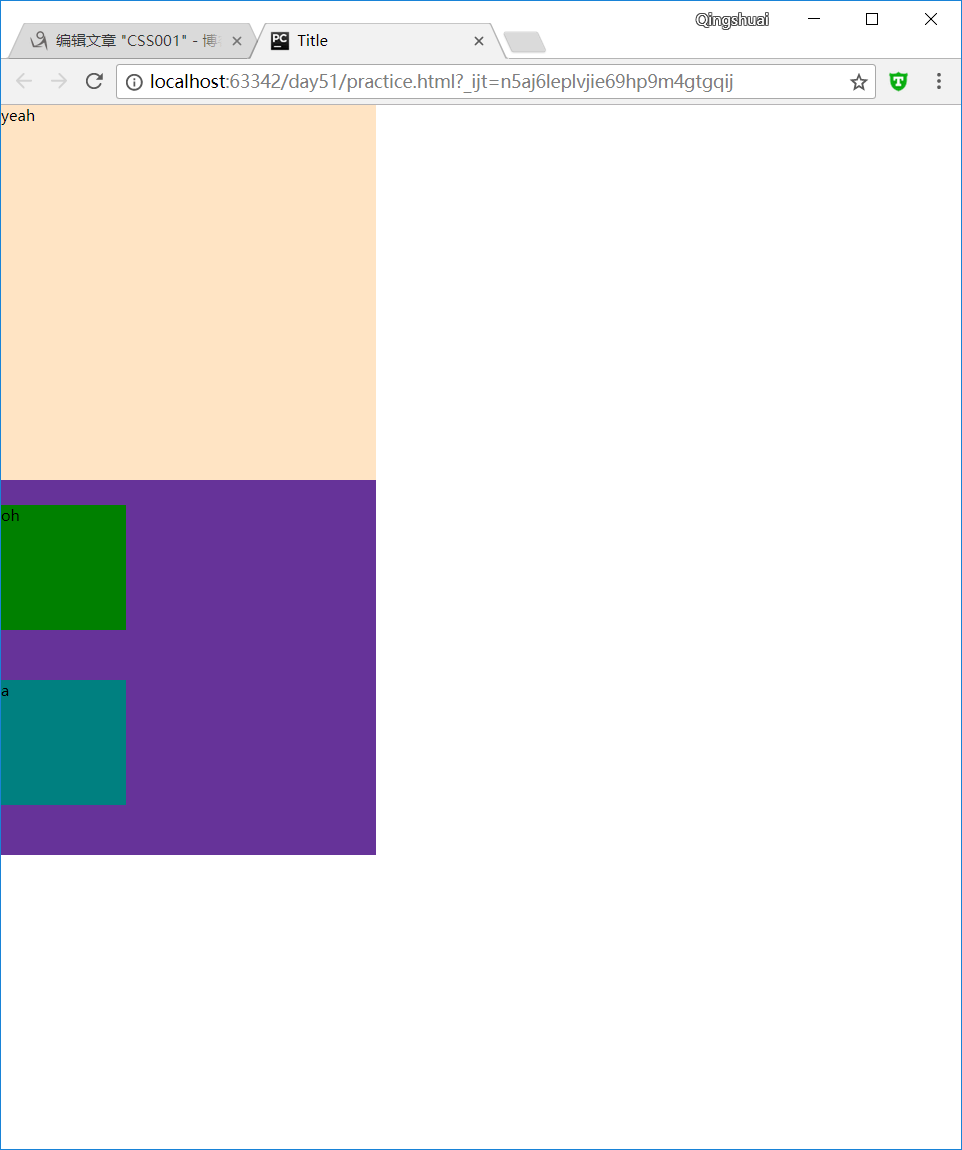
float属性
基本浮动规则
先来了解一下block元素和inline元素在文档流中的排列方式。
block元素通常被现实为独立的一块,独占一行,多个block元素会各自新起一行,默认block元素宽度自动填满其父元素宽度。block元素可以设置width、height、margin、padding属性;
inline元素不会独占一行,多个相邻的行内元素会排列在同一行里,直到一行排列不下,才会新换一行,其宽度随元素的内容而变化。inline元素设置width、height属性无效
- 常见的块级元素有 div、form、table、p、pre、h1~h5、dl、ol、ul 等。
- 常见的内联元素有span、a、strong、em、label、input、select、textarea、img、br等
所谓的文档流,指的是元素排版布局过程中,元素会自动从左往右,从上往下的流式排列。
脱离文档流,也就是将元素从普通的布局排版中拿走,其他盒子在定位的时候,会当做脱离文档流的元素不存在而进行定位。
假如某个div元素A是浮动的,如果A元素上一个元素也是浮动的,那么A元素会跟随在上一个元素的后边(如果一行放不下这两个元素,那么A元素会被挤到下一行);如果A元素上一个元素是标准流中的元素,那么A的相对垂直位置不会改变,也就是说A的顶部总是和上一个元素的底部对齐。此外,浮动的框之后的block元素会认为这个框不存在,但其中的文本依然会为这个元素让出位置。 浮动的框之后的inline元素,会为这个框空出位置,然后按顺序排列。
示例代码:
1.

<!DOCTYPE html> <html lang="en"> <head> <meta charset="UTF-8"> <title>Title</title> <style> *{ margin: 0; } .r1{ width: 300px; height: 100px; background-color: #7A77C8; float: left; } .r2{ width: 200px; height: 200px; background-color: wheat; float: left; } .r3{ width: 100px; height: 200px; background-color: darkgreen; float: left; } </style> </head> <body> <div class="r1"></div> <div class="r2"></div> <div class="r3"></div> </body> </html>
效果
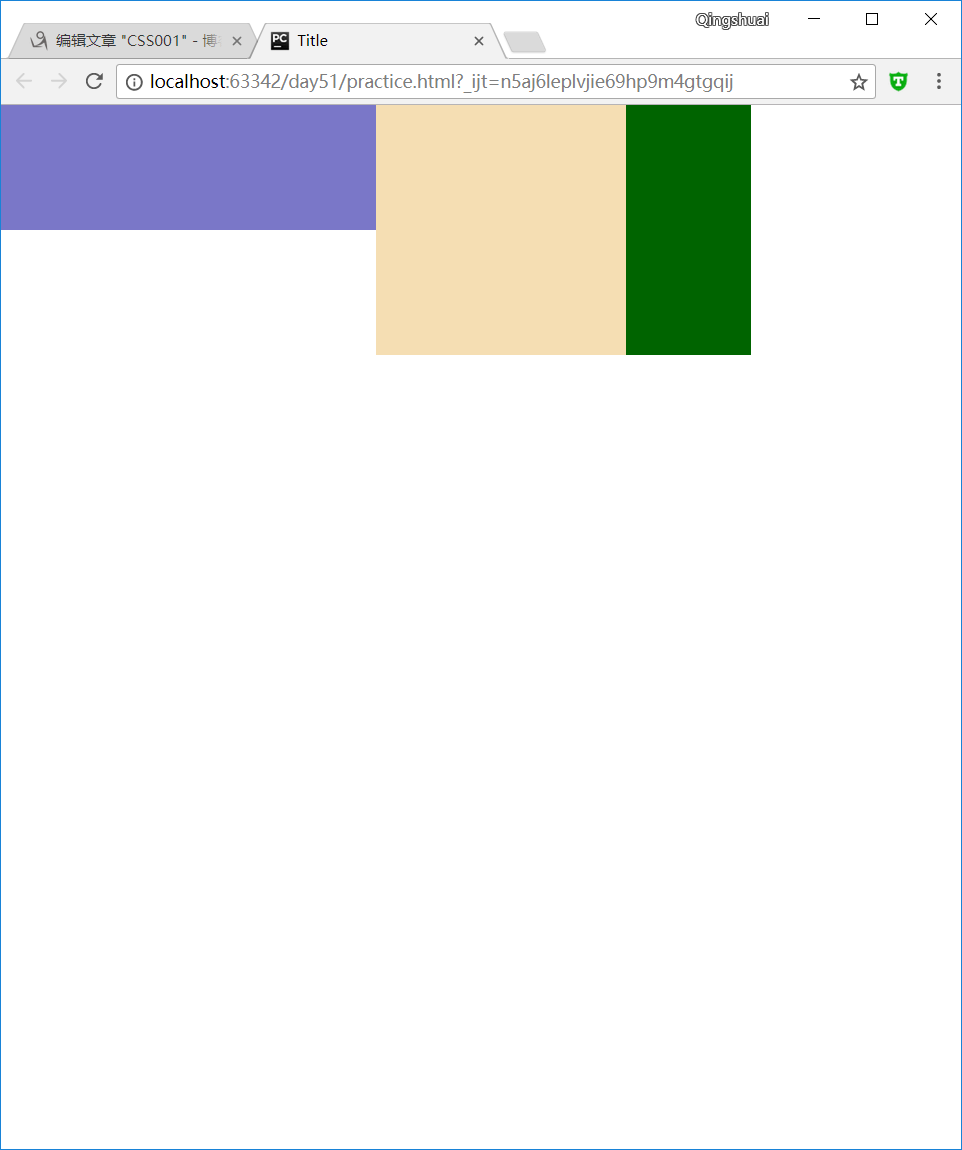
2.

<!DOCTYPE html> <html lang="en"> <head> <meta charset="UTF-8"> <title>Title</title> <style> *{ margin: 0; } .r1{ width: 300px; height: 100px; background-color: #7A77C8; /*float: left;*/ } .r2{ width: 200px; height: 200px; background-color: wheat; float: left; } .r3{ width: 100px; height: 200px; background-color: darkgreen; float: left; } </style> </head> <body> <div class="r1"></div> <div class="r2"></div> <div class="r3"></div> </body> </html>
效果

3.

<!DOCTYPE html> <html lang="en"> <head> <meta charset="UTF-8"> <title>Title</title> <style> *{ margin: 0; } .r1{ width: 300px; height: 100px; background-color: #7A77C8; float: left; } .r2{ width: 200px; height: 200px; background-color: wheat; /*float: left;*/ } .r3{ width: 100px; height: 200px; background-color: darkgreen; float: left; } </style> </head> <body> <div class="r1"></div> <div class="r2"></div> <div class="r3"></div> </body> </html>
效果

非完全脱离文档流
左右结构div盒子重叠现象,一般是由于相邻两个DIV一个使用浮动一个没有使用浮动。一个使用浮动一个没有导致DIV不是在同个“平面”上,但内容不会造成覆盖现象,只有DIV形成覆盖现象。
HTML文档示例:

<!DOCTYPE html> <html lang="en"> <head> <meta charset="UTF-8"> <title>Title</title> <style> *{ margin: 0; } .r1{ width: 100px; height: 100px; background-color: #7A77C8; float: left; } .r2{ width: 200px; height: 200px; background-color: wheat; /*float: left;*/ } </style> </head> <body> <div class="r1"></div> <div class="r2">region2</div> </body> </html>
Browser端展示:
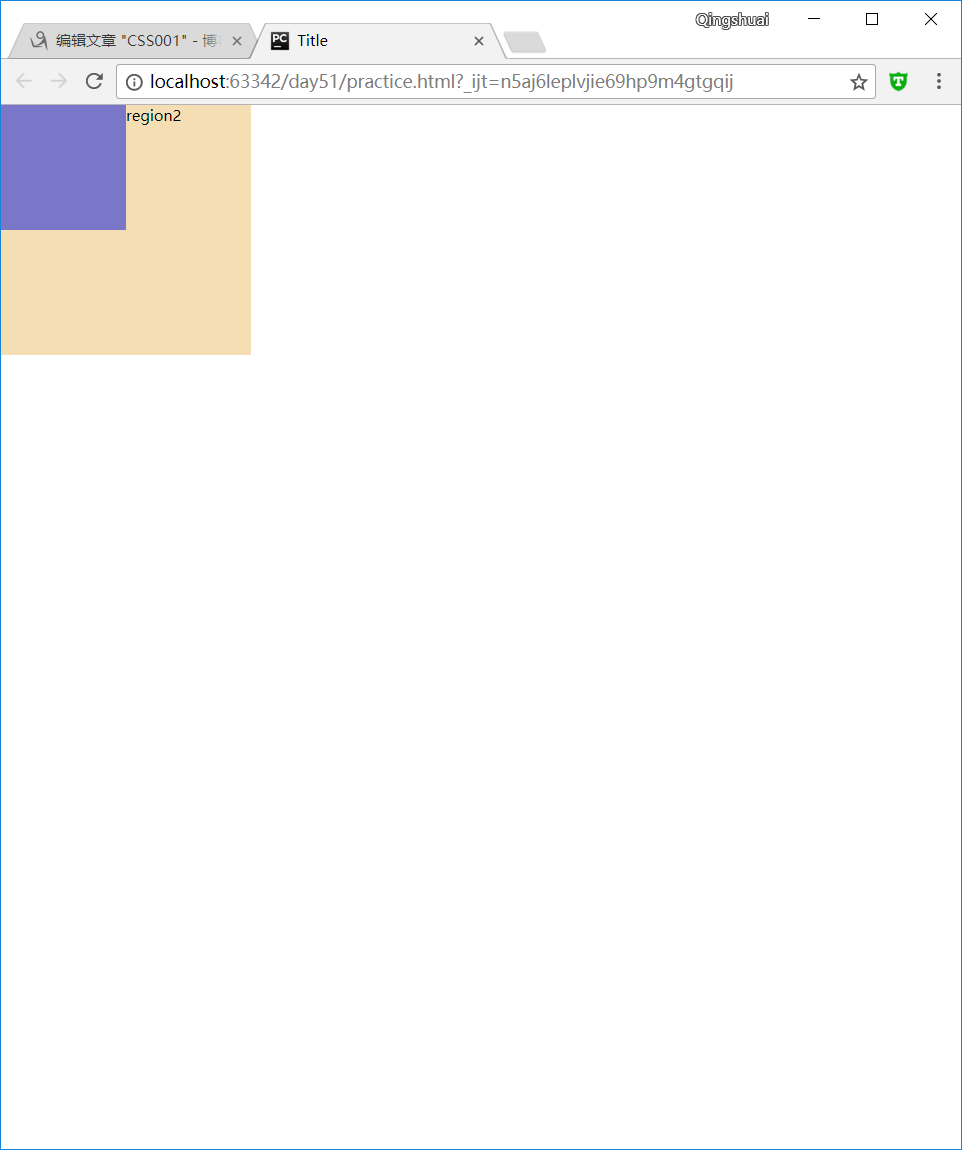
解决方法:要么都不使用浮动;要么都使用float浮动;要么对没有使用float浮动的DIV设置margin样式。
HTML示例文档:

<!DOCTYPE html> <html lang="en"> <head> <meta charset="UTF-8"> <title>Title</title> <style> *{ margin: 0; } .r1{ width: 100px; height: 100px; background-color: #7A77C8; float: left; } .r2{ width: 200px; height: 200px; background-color: wheat; float: left; } </style> </head> <body> <div class="r1"></div> <div class="r2">region2</div> </body> </html>
Browser端展示:

HTML文本示例:

<!DOCTYPE html> <html lang="en"> <head> <meta charset="UTF-8"> <title>Title</title> <style> *{ margin: 0; } .r1{ width: 100px; height: 100px; background-color: #7A77C8; /*float: left;*/ } .r2{ width: 200px; height: 200px; background-color: wheat; /*float: left;*/ } </style> </head> <body> <div class="r1"></div> <div class="r2">region2</div> </body> </html>
效果展示:

父级坍塌现象
HTML文本示例:

<!DOCTYPE html> <html lang="en"> <head> <meta charset="UTF-8"> <title>Title</title> <style type="text/css"> * { margin:0;padding:0; } .container{ border:1px solid red;width:300px; } #box1{ background-color:green;float:left;width:100px;height:100px; } #box2{ background-color:deeppink; float:right;width:100px;height:200px; } #box3{ background-color:pink;height:40px; } </style> </head> <body> <div class="container"> <div id="box1">box1 向左浮动</div> <div id="box2">box2 向右浮动</div> </div> <div id="box3">box3</div> </body> </html>
效果展示:
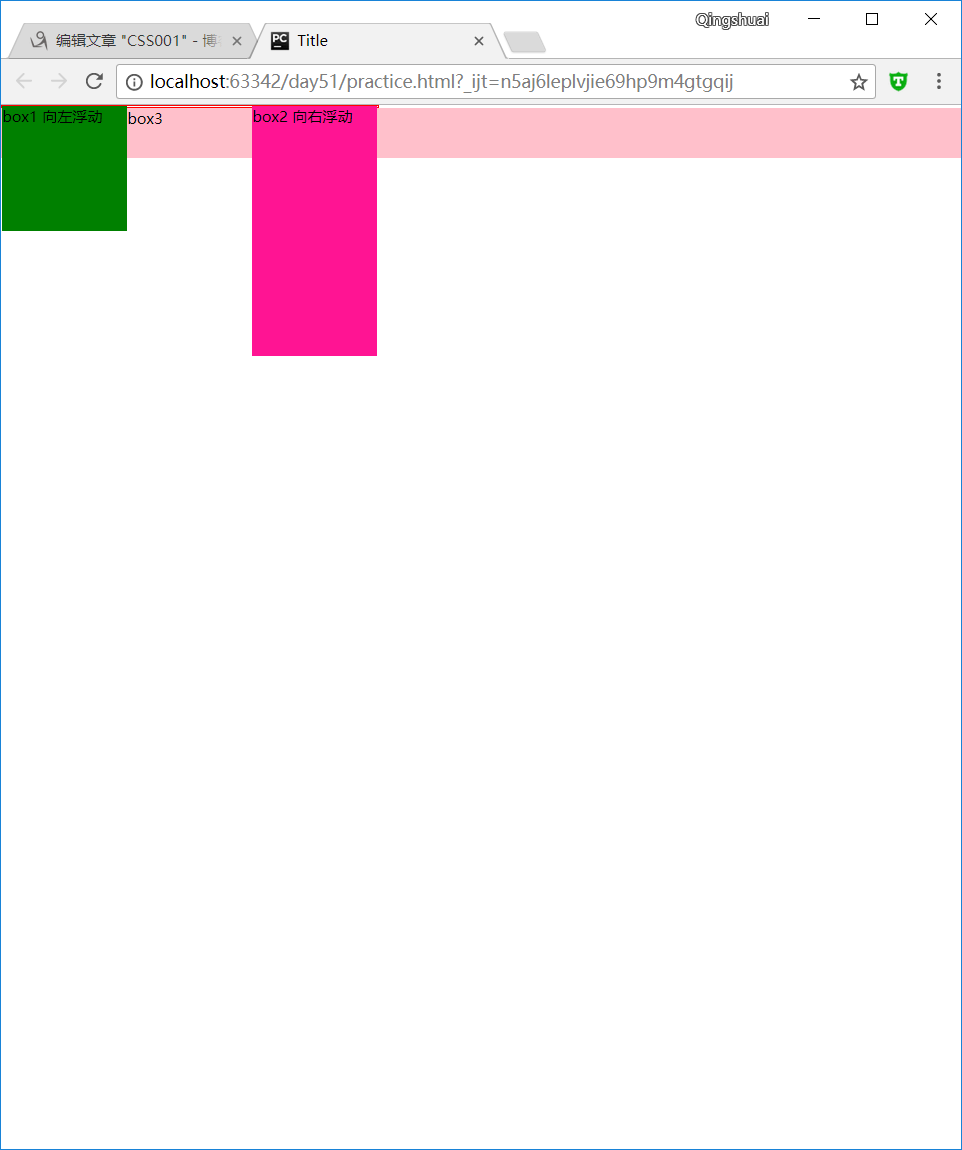
例子如上:.container和box3的布局是上下结构,上图发现box3跑到了上面,与.container产生了重叠,但文本内容没有发生覆盖,只有div发生覆盖现象。这个原因是因为第一个大盒子里的子元素使用了浮动,脱离了文档流,导致.container没有被撑开。box3认为.container没有高度(未被撑开),因此跑上去了。
解决方法:
1、固定高度
给.container设置固定高度,一般情况下文字内容不确定多少就不能设置固定高度,所以一般不能设置“.container”高度。
在能确定内容多高的情况下“.container”是可以设置一个高度,即可解决覆盖问题。
或者给.container加一个固定高度的子div:
<div class="container"> <div id="box1">box1 向左浮动</div> <div id="box2">box2 向右浮动</div> <div id="empty" style="height: 100px"></div> </div> <div id="box3">box3</div>
但是这样限定固定高度会使页面操作不灵活,不推荐!
HTML文本示例:

<!DOCTYPE html> <html lang="en"> <head> <meta charset="UTF-8"> <title>Title</title> <style type="text/css"> * { margin:0;padding:0; } .container{ border:1px solid red;width:300px; } #box1{ background-color:green;float:left;width:100px;height:100px; } #box2{ background-color:deeppink; float:right;width:100px;height:200px; } #box3{ background-color:pink;height:40px; } </style> </head> <body> <div class="container"> <div id="box1">box1 向左浮动</div> <div id="box2">box2 向右浮动</div> <div id="empty" style="height: 200px"></div> </div> <div id="box3">box3</div> </body> </html>
效果展示:

2、清除浮动(推荐)。
clear语法:
clear : none | left | right | both
取值:
none : 默认值。允许两边都可以有浮动对象
left : 不允许左边有浮动对象
right : 不允许右边有浮动对象
both : 不允许有浮动对象
但是需要注意的是:clear属性只会对自身起作用,而不会影响其他元素。
HTML文本示例:

<!DOCTYPE html> <html lang="en"> <head> <meta charset="UTF-8"> <title>Title</title> <style> *{ margin: 0; } .r1{ width: 300px; height: 100px; background-color: #7A77C8; float: left; } .r2{ width: 200px; height: 200px; background-color: wheat; float: left; clear: left; /*clear: right;*/ /*clear: both;*/ } .r3{ width: 100px; height: 200px; background-color: darkgreen; float: left; } </style> </head> <body> <div class="r1"></div> <div class="r2"></div> <div class="r3"></div> </body> </html>
效果展示:
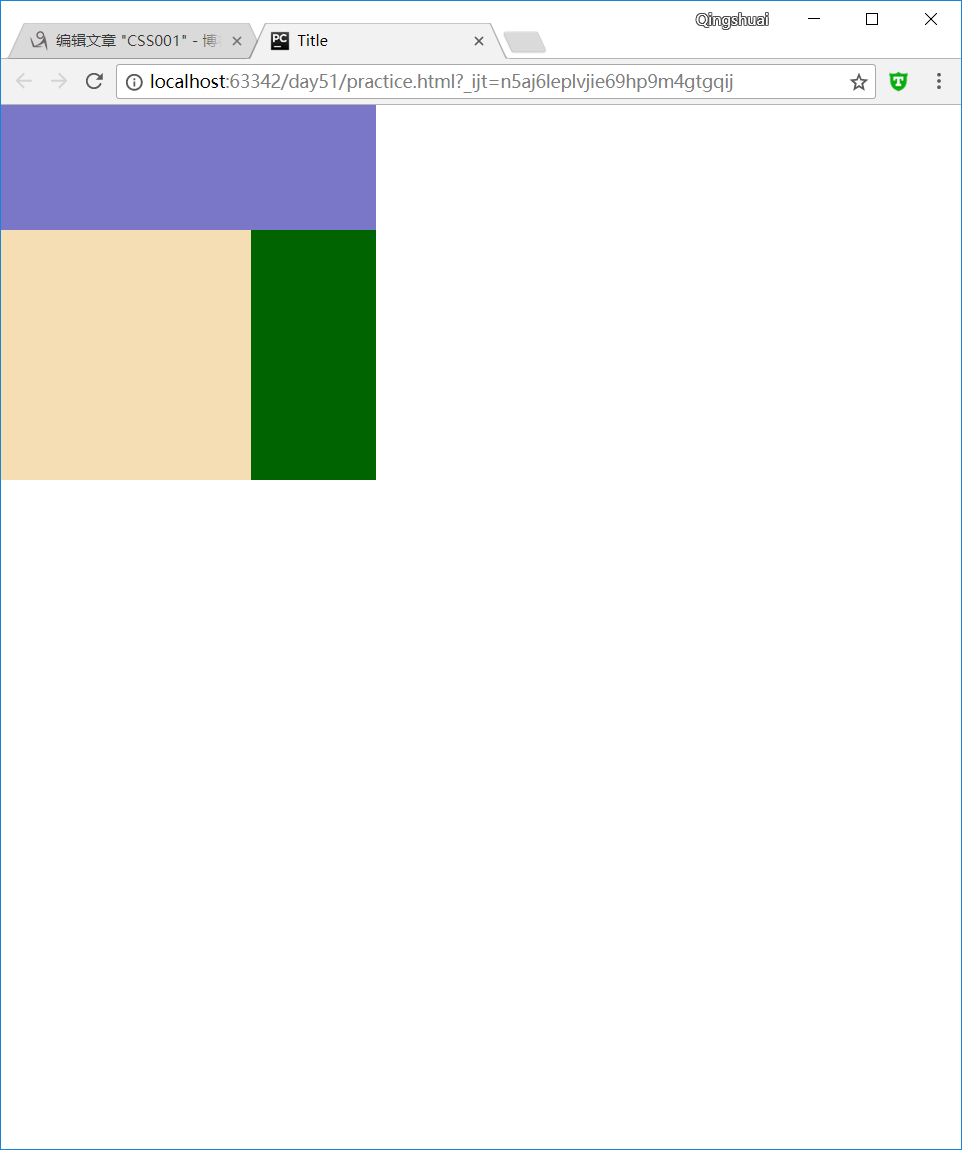
把握住两点:
1、元素是从上到下、从左到右依次加载的。
2、clear: left;对自身起作用,一旦左边有浮动元素,即切换到下一行来保证左边元素不是浮动的,依据这一点解决父级塌陷问题。
思考:

<!DOCTYPE html> <html lang="en"> <head> <meta charset="UTF-8"> <title>Title</title> <style> *{ margin: 0; } .r1{ width: 300px; height: 100px; background-color: #7A77C8; float: left; } .r2{ width: 200px; height: 200px; background-color: wheat; float: left; /*clear: left;*/ /*clear: right;*/ clear: both; } .r3{ width: 100px; height: 200px; background-color: darkgreen; float: left; } </style> </head> <body> <div class="r1"></div> <div class="r2"></div> <div class="r3"></div> </body> </html>
效果展示:

解决父级塌陷:
.clearfix:after { <----在类名为“clearfix”的元素内最后面加入内容;
content: "."; <----内容为“.”就是一个英文的句号而已。也可以不写。
display: block; <----加入的这个元素转换为块级元素。
clear: both; <----清除左右两边浮动。
visibility: hidden; <----可见度设为隐藏。注意它和display:none;是有区别的。
visibility:hidden;仍然占据空间,只是看不到而已;
line-height: 0; <----行高为0;
height: 0; <----高度为0;
font-size:0; <----字体大小为0;
}
.clearfix { *zoom:1;} <----这是针对于IE6的,因为IE6不支持:after伪类,这个神
奇的zoom:1让IE6的元素可以清除浮动来包裹内部元素。
整段代码就相当于在浮动元素后面跟了个宽高为0的空div,然后设定它clear:both来达到清除浮动的效果。
之所以用它,是因为,你不必在html文件中写入大量无意义的空标签,又能清除浮动。
<div class="head clearfix"></div>
HTML代码示例:

<!DOCTYPE html> <html lang="en"> <head> <meta charset="UTF-8"> <title>Title</title> <style type="text/css"> * { margin:0;padding:0; } .container{ border:1px solid red;width:300px; } #box1{ background-color:green;float:left;width:100px;height:100px; } #box2{ background-color:deeppink; float:right;width:100px;height:200px; } #box3{ background-color:pink;height:40px; } .clearfix:after { content: "."; display: block; clear: both; visibility: hidden; line-height: 0; height: 0; font-size:0; } </style> </head> <body> <div class="container"> <div id="box1">box1 向左浮动</div> <div id="box2">box2 向右浮动</div> <!--<div id="empty" style="height: 200px"></div>--> <div class="head clearfix"></div> </div> <div id="box3">box3</div> </body> </html>
效果展示:

3、overflow:hidden
overflow:hidden的含义是超出的部分要裁切隐藏,float的元素虽然不在普通流中,但是他是浮动在普通流之上的,可以把普通流元素+浮动元素想象成一个立方体。如果没有明确设定包含容器高度的情况下,它要计算内容的全部高度才能确定在什么位置hidden,这样浮动元素的高度就要被计算进去。这样包含容器就会被撑开,清除浮动。
HTML文本示例:

<!DOCTYPE html> <html lang="en"> <head> <meta charset="UTF-8"> <title>Title</title> <style type="text/css"> * { margin:0;padding:0; } .container{ border:1px solid red;width:300px;overflow: hidden; } #box1{ background-color:green;float:left;width:100px;height:100px; } #box2{ background-color:deeppink; float:right;width:100px;height:200px; } #box3{ background-color:pink;height:40px; } </style> </head> <body> <div class="container"> <div id="box1">box1 向左浮动</div> <div id="box2">box2 向右浮动</div> </div> <div id="box3">box3</div> </body> </html>
效果展示:

position(定位)
1 static
static 默认值,无定位,不能当作绝对定位的参照物,并且设置标签对象的left、top等值是不起作用的。
2 position: relative/absolute
relative: 相对定位
相对定位是相对于该元素在文档流中的原始位置,即以自己原始位置为参照物。有趣的是,即使设定了元素的相对定位以及偏移值,元素还占有着原来的位置,即占据文档流空间。对象遵循正常文档流,但将依据top,right,bottom,left等属性在正常文档流中偏移位置。而其层叠通过z-index属性定义。
注意:position:relative的一个主要用法:方便绝对定位元素找到参照物。
absolute: 绝对定位
定义:设置为绝对定位的元素框从文档流完全删除,并相对于最近的已定位祖先元素定位,如果元素没有已定位的祖先元素,那么它的位置相对于最初的包含块(即body元素)。元素原先在正常文档流中所占的空间会关闭,就好像该元素原来不存在一样。元素定位后生成一个块级框,而不论原来它在正常流中生成何种类型的框。
重点:如果父级设置了position属性,例如position:relative;,那么子元素就会以父级的左上角为原始点进行定位。这样能很好的解决自适应网站的标签偏离问题,即父级为自适应的,那我子元素就设置position:absolute;父元素设置position:relative;,然后Top、Right、Bottom、Left用百分比宽度表示。
另外,对象脱离正常文档流,使用top,right,bottom,left等属性进行绝对定位。而其层叠通过z-index属性定义。
示例代码(相对位置移动):

<!DOCTYPE html> <html lang="en"> <head> <meta charset="UTF-8"> <title>Title</title> <style> *{ margin: 0; } .outet{ /*position: relative;*/ } .item{ width: 200px; height:200px; } .r1{ background-color: #7A77C8; } .r2{ background-color: wheat; position: relative; top: 200px; left: 200px; } .r3{ background-color: darkgreen; } </style> </head> <body> <div class="item r1"></div> <div class="outet"> <div class="item r2"></div> <div class="item r3"></div> </div> </body> </html>
效果展示:
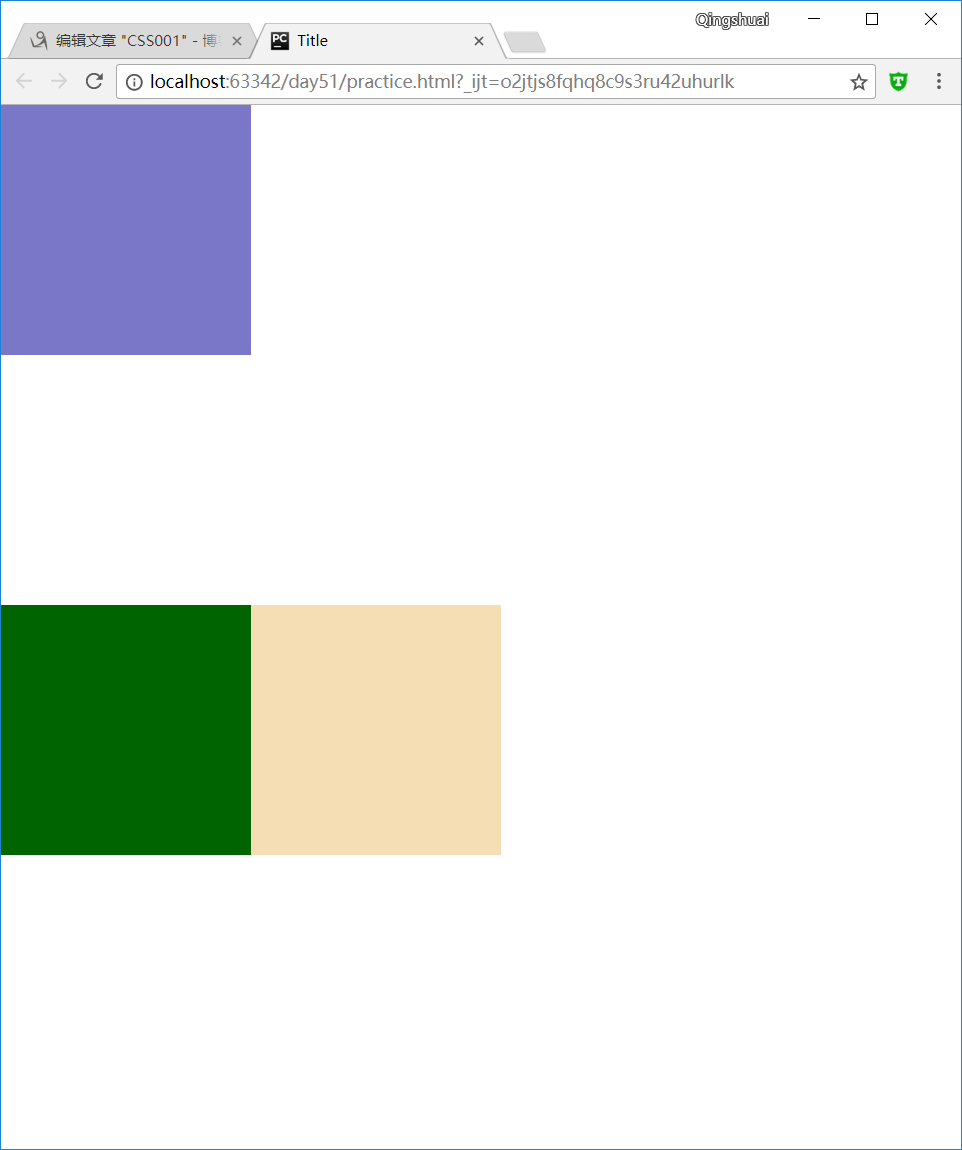
代码示例(绝对位置移动):

<!DOCTYPE html> <html lang="en"> <head> <meta charset="UTF-8"> <title>Title</title> <style> *{ margin: 0; } .outet{ /*position: relative;*/ } .item{ width: 200px; height:200px ; } .r1{ background-color: #7A77C8; } .r2{ background-color: wheat; position: absolute; top: 200px; left: 200px; } .r3{ background-color: darkgreen; } </style> </head> <body> <div class="item r1"></div> <div class="outet"> <div class="item r2"></div> <div class="item r3"></div> </div> </body> </html>
效果展示:

总结:参照物用相对定位,子元素用绝对定位,并且保证相对定位参照物不会偏移即可。
3 position:fixed
fixed:对象脱离正常文档流,使用top,right,bottom,left等属性以窗口为参考点进行定位,当出现滚动条时,对象不会随着滚动。而其层叠通过z-index属性 定义。 注意点: 一个元素若设置了 position:absolute | fixed; 则该元素就不能设置float。这 是一个常识性的知识点,因为这是两个不同的流,一个是浮动流,另一个是“定位流”。但是 relative 却可以。因为它原本所占的空间仍然占据文档流。
在理论上,被设置为fixed的元素会被定位于浏览器窗口的一个指定坐标,不论窗口是否滚动,它都会固定在这个位置。
示例代码:

<!DOCTYPE html> <html lang="en"> <head> <meta charset="UTF-8"> <title>Title</title> <style> *{ margin: 0; } .back{ background-color: wheat; width: 100%; height: 1200px; } span{ display: inline-block; width: 80px; height: 50px; position: fixed; bottom: 20px; right: 20px; background-color: rebeccapurple; color: white; text-align: center; line-height: 50px; } </style> </head> <body> <div class="back"> <span>返回顶部</span> </div> </body> </html>
效果展示:

Caution!
1、默认的高度和宽度问题
(1)父子都是块级元素
代码示例:

<!DOCTYPE html> <html> <head> <title>fortest</title> <style> div.parent{ width: 500px; height: 300px; background: #ccc; } div.son{ width: 100%; height: 200px; background: green; } </style> </head> <body> <div class="parent"> <div class="son"></div> </div> </body> </html>
效果展示:
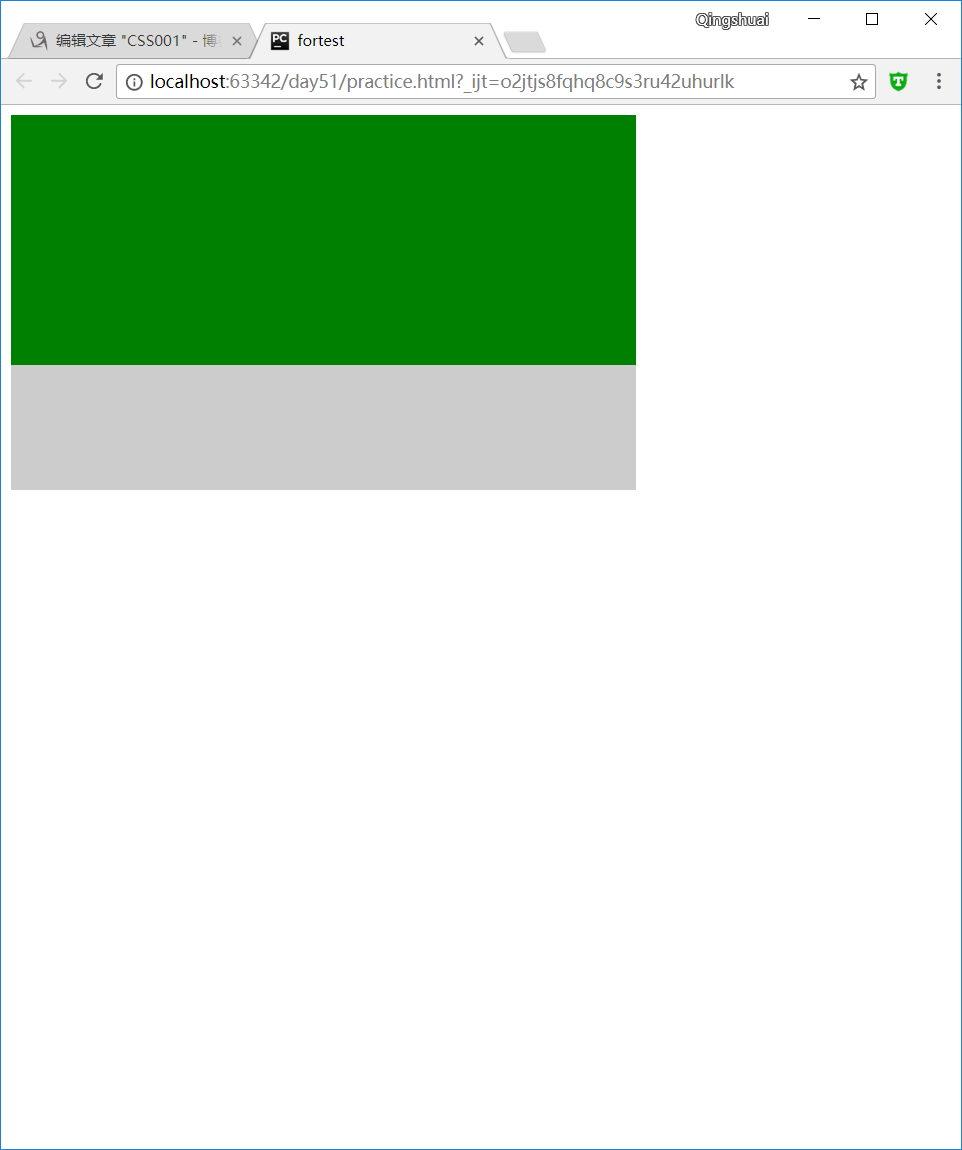
这时,子元素设置为了父元素width的100%,那么子元素的宽度也是500px;
但是如果我们把子元素的width去掉之后,就会发现子元素还是等于父元素的width。也就是说,对于块级元素,子元素的宽度默认为父元素的100%。
当我们给子元素添加padding和margin时,可以发现宽度width是父元素的宽度减去子元素的margin值和padding值。
毫无疑问,如果去掉子元素的height,就会发先子元素的高度为0,故height是不会为100%的,一般我们都是通过添加内容(子元素)将父元素撑起来。
代码示例:

<!DOCTYPE html> <html> <head> <title>fortest</title> <style> body{ margin: 0px; } div.parent{ width: 500px; height: 300px; background: #ccc; overflow: hidden; } div.son{ /*width: 100%;*/ height: 200px; background: green; padding: 20px; margin: 10px; } </style> </head> <body> <div class="parent"> <div class="son">yeah</div> </div> </body> </html>
效果展示:
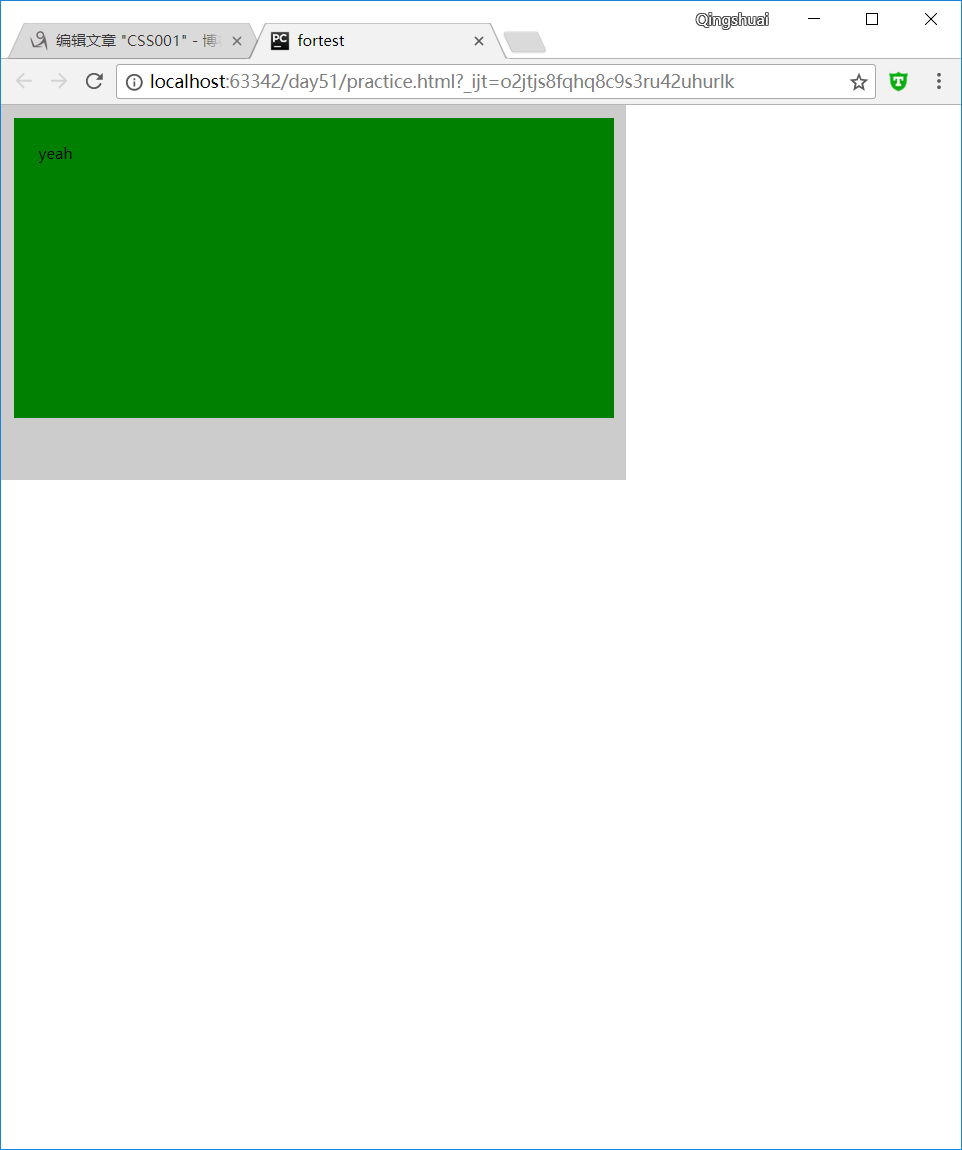
(2)父:块级元素 子:内联元素
如果内联元素是不可替换元素(除img,input以外的一般元素),元素是没有办法设置宽度的,也就谈不上100%的问题了。 即内联元素必须依靠其内部的内容才能撑开。
如果内联元素是可替换元素(img,input,本身可以设置长和宽),不管怎么设置父元素的宽度和高度,而不设置img的宽和高时,img总是表现为其原始的宽和高。
代码示例:

<!DOCTYPE html> <html> <head> <title>...</title> <style> div.parent{ width: 500px; height: 300px; background: #ccc; } img{ /*height: 100px;*/ background: green; } </style> </head> <body> <div class="parent"> <img class="son" src="drawlogo.png"></img> </div> </body> </html>
效果展示:
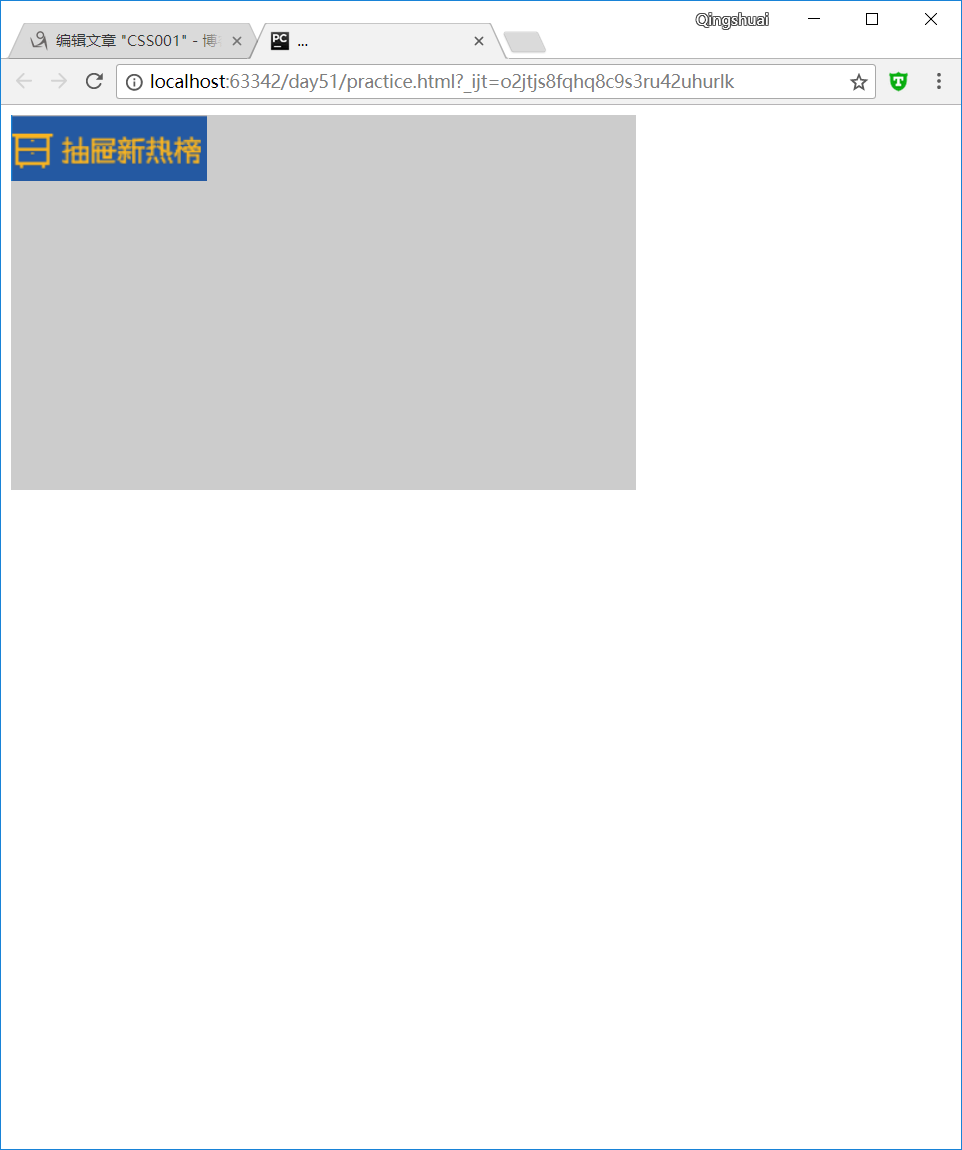
由此我们可以发现,虽然没有设置宽度,但是表现在浏览器上为157px,它并没有继承父元素的100%得到500px,而是根据既定的高度来等比例缩小宽度。同样, 如果只设置width,那么height也会等比例改变。(照片大小:157*53)
如果我们把img的width设置为100%,就可以发现其宽度这时就和父元素的宽度一致了。而我们一般的做法时,首先确定img的父元素的宽度和高度,然后再将img的宽度和高度设置位100%,这样,图片就能铺满父元素了。
代码示例(默认原始比例):

<!DOCTYPE html> <html> <head> <title>...</title> <style> div.parent{ width: 500px; height: 300px; background: #ccc; } img{ /*width: 400px;*/ /*height: 100px;*/ /*width: 100%;*/ /*height: 100%;*/ background: green; } </style> </head> <body> <div class="parent"> <img class="son" src="drawlogo.png"></img> </div> </body> </html>
效果展示:
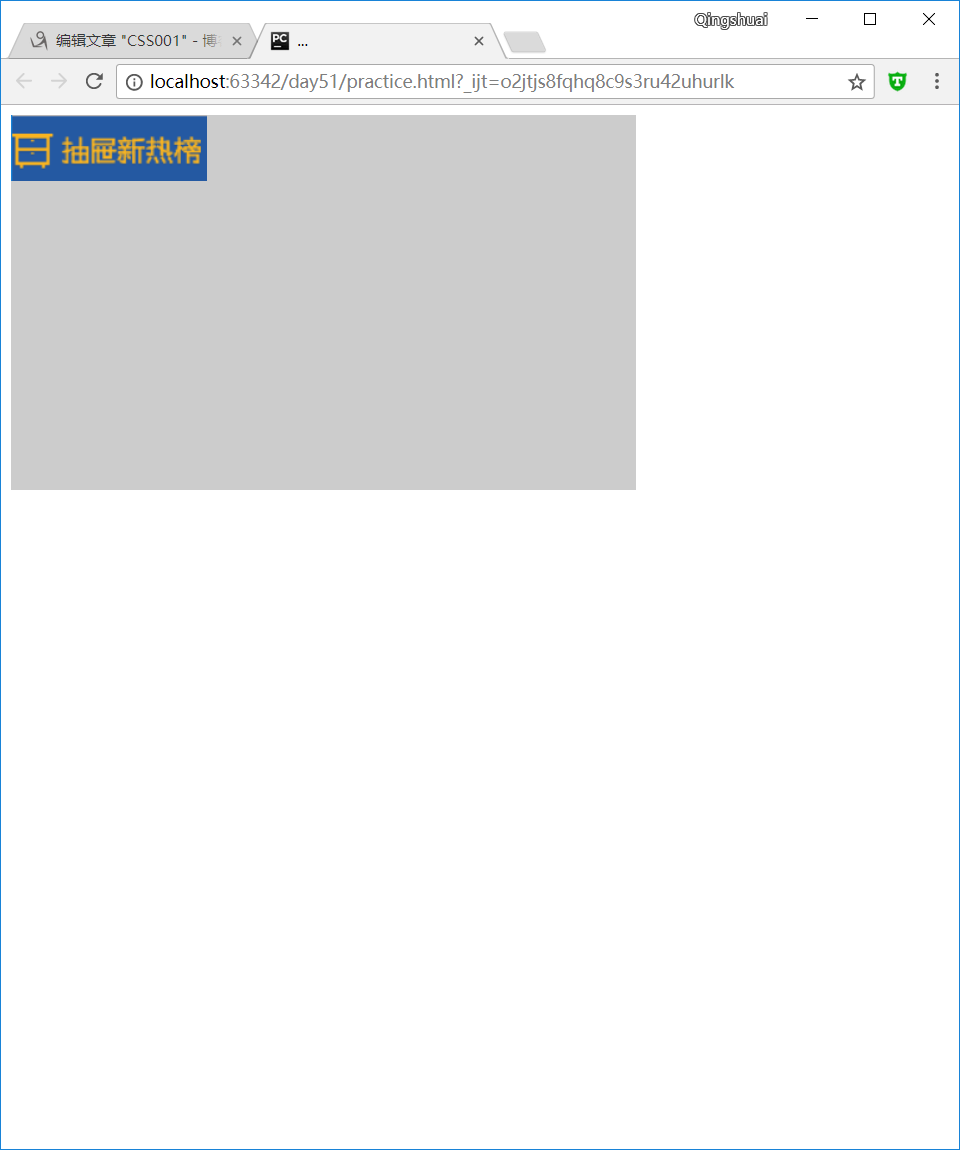
代码示例(等比例改变):

<!DOCTYPE html> <html> <head> <title>...</title> <style> div.parent{ width: 500px; height: 300px; background: #ccc; } img{ width: 400px; /*height: 100px;*/ /*width: 100%;*/ /*height: 100%;*/ background: green; } </style> </head> <body> <div class="parent"> <img class="son" src="drawlogo.png"></img> </div> </body> </html>
效果展示:
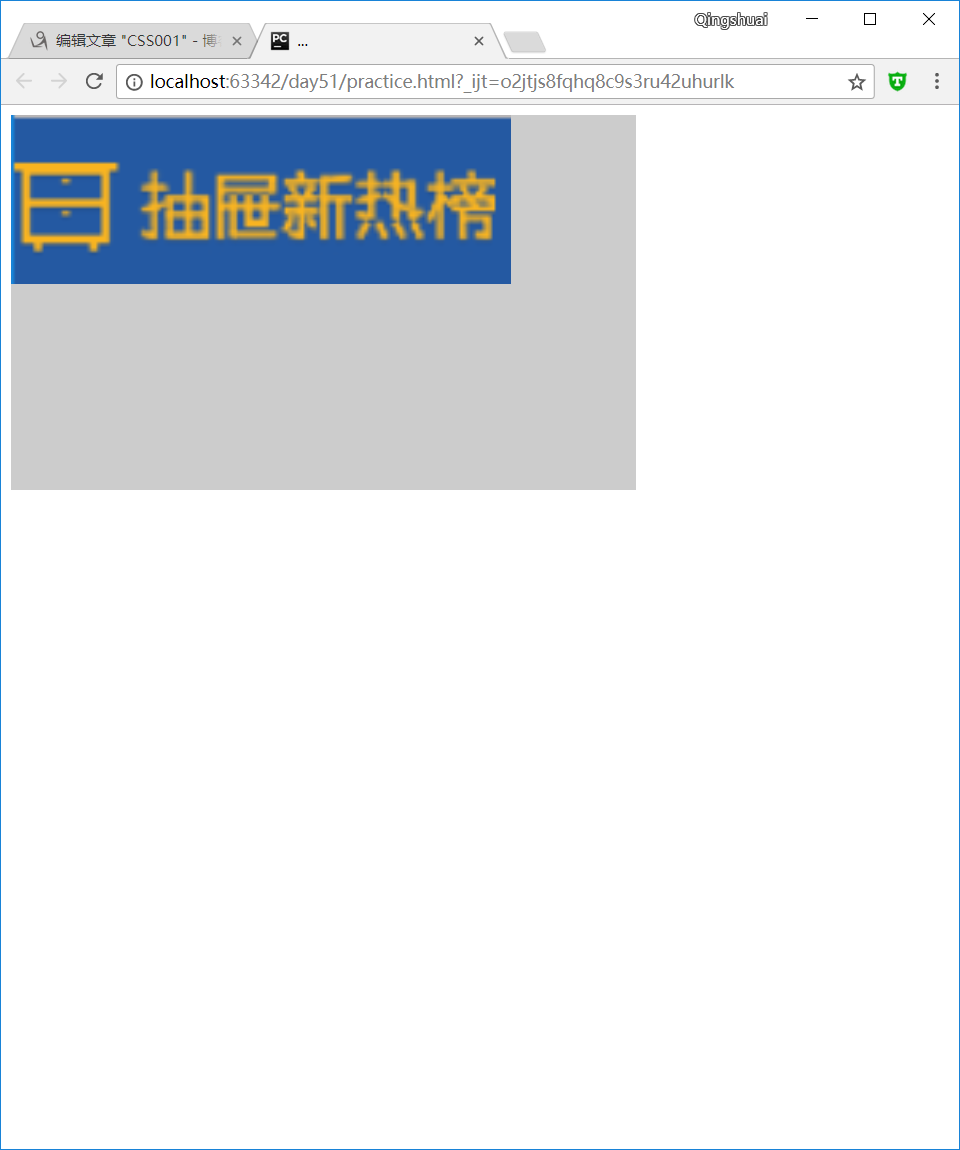
代码示例(铺满父元素):

<!DOCTYPE html> <html> <head> <title>...</title> <style> div.parent{ width: 500px; height: 300px; background: #ccc; } img{ /*width: 400px;*/ /*height: 100px;*/ width: 100%; height: 100%; background: green; } </style> </head> <body> <div class="parent"> <img class="son" src="drawlogo.png"></img> </div> </body> </html>
效果展示:

后台管理布局
代码示例:

<!DOCTYPE html> <html lang="en"> <head> <meta charset="UTF-8"> <title>Title</title> <style> .pg-header{ height: 48px; width: 100%; background-color: #2459a2; position: fixed; top:0; left: 0; } .left{ position:absolute; left:0; top:48px; bottom:0; width:200px; background-color: #ededed; } .right{ position:absolute; right:0; left:200px; top:48px; bottom:0; overflow:auto; } .content{ height: 2000px; width: 100%; } </style> </head> <body> <div class="pg-header"></div> <div> <div class="left"></div> <div class="right"> <div class="content"></div> </div> </div> </body> </html>
效果展示:

css响应式布局
代码示例:

<!DOCTYPE html> <html lang="en"> <head> <meta charset="UTF-8"> <title>Title</title> <style> /*======================================初始化=====================*/ *{ margin: 0; padding: 0; } body{ font-size: 12px; } a{ text-decoration: none; } /*======================================header区域设置=====================*/ .header{ height: 44px; width: 100%; background-color: #2459a2; position: fixed; top:0; left: 0; } .header_content{ width: 80%; height: 44px; background-color: #2459a2; margin: 0 auto; line-height: 44px; position: relative; } /*======header区part1:logo ===========*/ .logo{ float: left; width: 121px; height: 23px; margin-top: 9px; } /*======header区part2:action-menu =====*/ .action-menu{ float: left; margin-left: 30px; } .action-menu a.tb{ color: #c0cddf; padding: 0 10px; text-align: center; margin-left: -3px; display: inline-block; } .action-menu a.tb:hover { color: #fff; background-color: lightslategrey; } .action-menu a.active, .action-menu a.active:hover { color: #fff; background-color:#204982;; } /*======header区part3:key-search =====*/ .key-search{ margin-top: 5px; float: right; } .key-search a.search-icon-box, .search-txt { float: left; } .search-txt { color: #333; line-height: 25px; padding: 2px 2px 2px 5px; height: 25px; width: 91px; } .key-search a.search-icon-box { border: 1px solid #e0e0e0; background-color: #f4f4f4; width: 30px; height: 31px; border-left: 0; } .key-search a.search-icon-box span.search-icon{ background: url("icon.png") no-repeat 0 -197px; float: left; height: 12px; width: 11px; margin-left: 10px; margin-top: 9px; } /*======header区part4:action-nav =====*/ .action-nav { float: right; margin-right: 10px; } .action-nav a { color: white; padding: 14px 18px; } .action-nav a:hover{ background-color: lightslategrey; color: white; } /*======================================content区域设置=====================*/ .content-box { background-color: #ededed; padding-top: 44px; height: 100%; } .content { width: 960px; margin: 0 auto; height: auto!important; overflow: hidden; min-height: 713px; padding: 6px 28px; background-color: #fff; /*overflow: hidden;取消后看看效果*/ } /*===============================响应式布局=====================*/ @media(max-width:1050px) { .action-menu a.item{ display: none; background-color: gold; border: dashed 1px rebeccapurple; color: black; } .action-menu a.active{ padding: 0 25px; } .action-nav{ float: left; margin-left: 80px; } .key-search{ float: right; margin-right: 100px; } .action-menu:hover a.item{ display: block; } } @media(max-width:810px) { .key-search{ display: none; } .action-nav{ display: none; } } </style> </head> <body> <!--header结构--> <div class="header"> <div class="header_content"> <div class="logo"> <a href="/"><img src="logo.png" alt=""></a> </div> <div class="action-menu"> <a href="#" class="tb active">全部</a> <a href="#" class="tb item">42区</a> <a href="#" class="tb item">段子</a> <a href="#" class="tb item">图片</a> <a href="#" class="tb item">挨踢1024</a> <a href="#" class="tb item">你问我答</a> </div> <div class="key-search"> <form action="/" method="post"> <input type="text" class="search-txt"> <a href="#" class="search-icon-box" > <span class="search-icon"></span> </a> </form> </div> <div class="action-nav"> <a href="#" class="register-btn">注册</a> <a href="#" class="login-btn">登录</a> </div> </div> </div> <!--content结构--> <div class="content-box"> <div class="content"> </div> </div> </body> </html>
效果展示图:
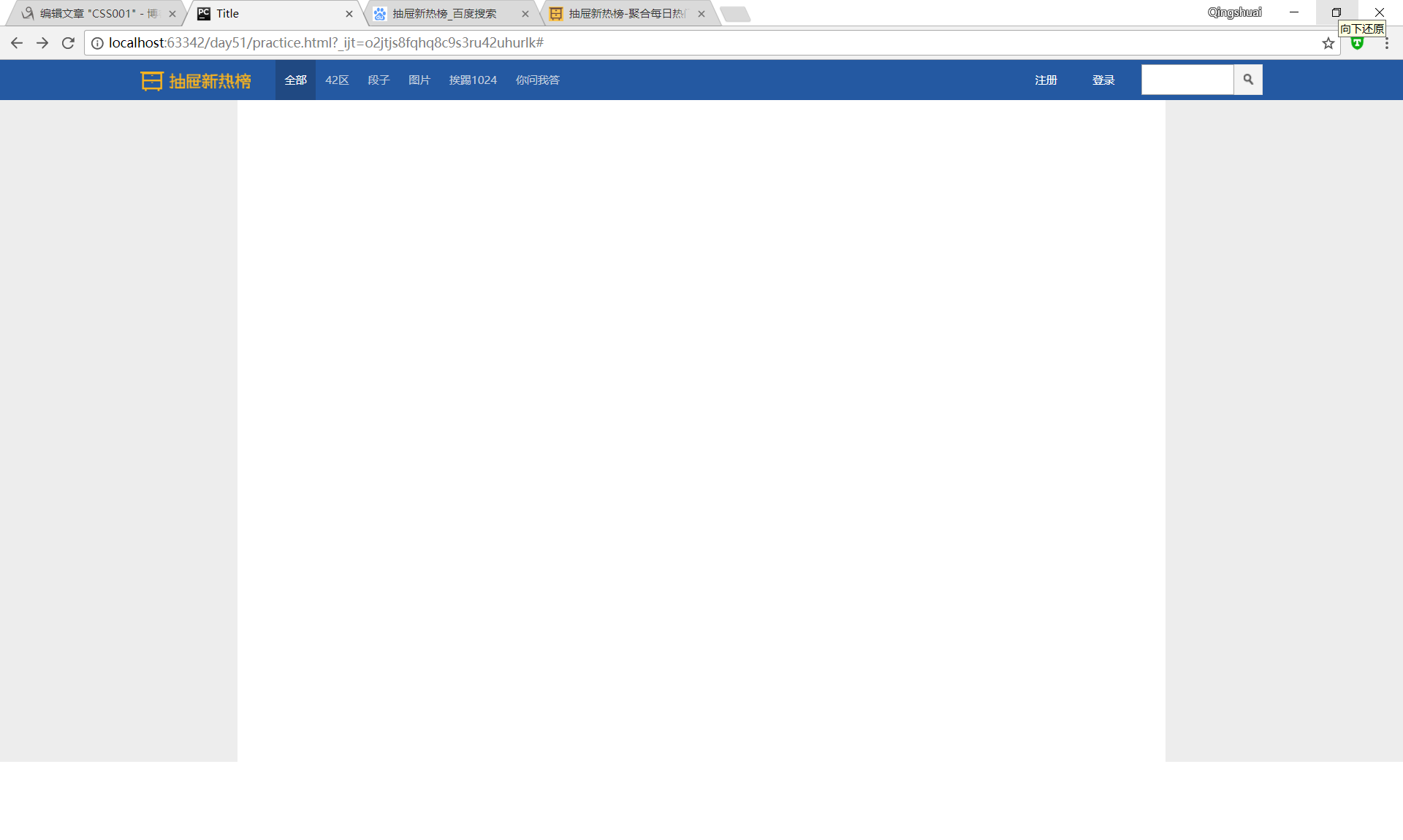
练习:
登陆页面





